Crafting an Effective Letter of Assignment: A Comprehensive Guide with Sample
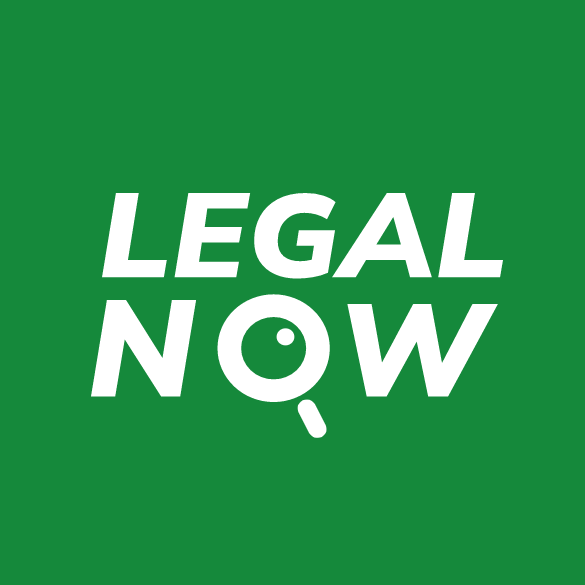
A letter of assignment is a critical document in various business, academic, and professional settings. It formally assigns responsibilities, tasks, or roles from one party to another. Understanding how to craft an effective letter of assignment can ensure clear communication and smooth transitions in responsibilities. This guide will explore the essential components of a letter of assignment, provide legal considerations, and offer a sample letter to help you draft your own.


Understanding the Letter of Assignment
What is a letter of assignment.
A letter of assignment is a document that formally assigns a specific task, responsibility, or job from one individual or organization to another. It is commonly used in settings such as journalism, where assignments are delegated to reporters, or in project management, where specific tasks are assigned to team members.
For more information on the role of assignments in organizational management, Harvard Business School provides a wealth of resources on organizational behavior.
Key Elements of a Letter of Assignment
Introduction : Clearly state the purpose of the letter.
Details of the Assignment : Specify the task or responsibility being assigned, including any relevant deadlines or expectations.
Resources and Authority : Outline any resources that will be provided to assist with the assignment and any authority the assignee has over others.
Expectations and Goals : Clearly define what success looks like for the assignment.
Duration of the Assignment : If applicable, state the start and end dates.
Contact Information : Provide contact details for someone who can offer assistance or answer questions related to the assignment.
To see a general template of business documents, including assignment letters, visit Purdue University’s Online Writing Lab.
Legal Considerations
When crafting a letter of assignment, it's essential to ensure that it does not violate any contractual agreements or employment laws. Consult legal resources or an attorney to confirm that all aspects of your letter are compliant with local and federal laws. The U.S. Small Business Administration offers guidelines on employment and labor laws that might be relevant.
Sample Letter of Assignment
Note: This sample is for illustrative purposes only and should be customized to meet specific needs and legal requirements.
[Your Name] [Your Position] [Your Company/Organization] [Your Address] [City, State, Zip Code] [Email Address] [Phone Number] [Date] [Recipient Name] [Recipient Position] [Company/Organization] [Recipient Address] [City, State, Zip Code] Dear [Recipient Name], Subject: Assignment of [Task/Responsibility/Project Name] I am writing to formally assign you the responsibility of [brief description of the task or responsibility]. This assignment will commence on [start date] and will conclude on [end date], unless extended by mutual agreement. Details of the Assignment: - **Task Description**: [Detailed description of the task, including any specific expectations or deliverables.] - **Resources Provided**: [List of resources or support to be provided, including access to systems, budget information, etc.] - **Authority**: You will have the authority to [describe any authority over staff, budgets, decisions]. - **Goals and Objectives**: The primary goal of this assignment is [describe what successful completion of the assignment looks like]. Please confirm your acceptance of this assignment by signing and returning a copy of this letter. Should you have any questions or require further clarification, do not hesitate to contact me directly at [your phone number] or [your email]. Thank you for your attention to this matter and your continued contribution to our team. Sincerely, [Your Signature (if sending a hard copy)] [Your Typed Name] [Your Position] [Enclosures: if any]
Best Practices for Letter of Assignment
Clarity and conciseness.
Ensure that the letter is clear and concise. Avoid ambiguity about the responsibilities or expectations to prevent misunderstandings.
After sending the letter, follow up to ensure that the recipient has understood everything and agrees to the terms laid out in the letter.
Record Keeping
Keep a copy of the signed letter for your records. This can be useful for future reference or in case of disputes.

50% OFF ONE WEEK ONLY
Quick Creator is the ultimate solution for digital marketers who need high-converting landing pages quickly and easily. Say goodbye to the old, time-consuming methods and hello to the future of digital marketing.

A well-crafted letter of assignment not only clarifies roles and responsibilities but also sets the stage for successful project execution and employee engagement. By adhering to legal standards and following the guidelines provided, you can ensure that these documents are both effective and compliant. For further reading on employment and assignment contracts, visit Harvard University's Employment and Labor Law page .
Create & Review All Your Contracts Online With LegalNow AI

© Copyright 2024 LegalNow - All Rights Reserved.
decriminalization of drugs canada essay

Decriminalization failures show half measures are not enough to address drug use problems and the opioid crisis
Professor, Department of Sociology and Anthropology, University of Guelph
Disclosure statement
Andrew Hathaway does not work for, consult, own shares in or receive funding from any company or organisation that would benefit from this article, and has disclosed no relevant affiliations beyond their academic appointment.
University of Guelph provides funding as a founding partner of The Conversation CA.
University of Guelph provides funding as a member of The Conversation CA-FR.
View all partners
Ottawa’s recent rejection of the City of Toronto’s request to decriminalize possession of controlled drugs is the latest shoe to drop in the resurgence of conservative anti-drug sentiment sweeping the country, and backtracking on reforms achieved in other jurisdictions.
The announcement, citing concern for public safety, follows much the same script as that of the British Columbia government, which — after decriminalizing in 2023 — recently retreated to ban use in public places due to complaints of rampant drug use and continuing high rates of overdose.
In early April, the state of Oregon went further , recriminalizing drug possession, replacing small fines with probation and up to six months in prison. The state was forced to backtrack on decriminalization measures that were passed in 2020 due to backlash over spiking overdoses during the COVID-19 lockdown period.
Continued deaths due to drug use is all the evidence required to curb reform, despite the fact that these spikes occurred mostly during the pandemic.
Research shows that the pandemic exacerbated many of the factors underlying the drug crisis. Health disparities and a lack of resources in underserved communities, social isolation, economic burden, stress, a lack of access to treatment and barriers to care all contribute to acute health effects of drug dependence.
Regardless of these facts, drug policy reform is being blamed for these outcomes.
It’s still all about the politics, of course

In Ontario, predictably, the Ford government’s position on Toronto’s proposal is staunch opposition . Yet there is a sense of new momentum in the same old rhetoric: because drug users continue to die and use drugs in public places, presumably this means the experts and bleeding-heart liberals who supported reform have been soundly proven wrong.
Most concerning, whereas conservatives and liberals may differ in their emphasis on punishment or treatment as solutions to drug problems, neither type of government seems prepared to fully implement a public health approach to substance use. That would mean addressing health disparities and deeper causes of substance use disorders, such as social inequality and social dislocation in Canadian society.
No North American jurisdiction has been able to achieve this, despite the depth of knowledge and increasingly articulate demonstration of progressive public servants. Bureaucrats and politicians speak the language used by experts and other knowledgeable observers, who in turn inform the public of the need for harm reduction and more comprehensive, meaningful social policy reform. Logically, this requires commitment to decriminalization to shift the emphasis from punishing addicts to rehabilitating them.
Increasingly, the discourse has gone further in establishing the need for more coherent public health policies addressing the root causes of addiction. To that end, important progress has been squandered by apparent bewilderment that addicts are still dying in large numbers, despite (and now because of) decriminalization measures that were never claimed to solve the problem of addiction, but rather to reduce known harms of criminalizing drugs .
Decriminalizing drugs is not intended to be a solution to drug problems. Rather, it is a critical first step that’s necessary, but not sufficient, for replacing prohibition with a public health approach.
Although Canada has made this work for regulating cannabis , it still has far to go to implement a more progressive public health approach to other drugs. The dangers of drug use stem not so much from psychoactive substances themselves, but from the toxic and unsafe drug supply that is the result of criminalization. But most of these substances continue to be treated as dangerous enough to ban.
Yet there is scant consideration of the societal and legal circumstances and conditions that make drugs dangerous because they happen to be used in harmful ways by certain people. Whereas opiates , like alcohol , may have higher risk of overdose and adverse health effects due to physical dependence , all drugs can be misused with risk to health and public safety.
Addiction and public health

Decriminalizing drugs can make them safer, but not always, and reduce some harms of using drugs. What cannot be resolved entirely by decriminalization are the societal conditions that make substance use attractive enough to override considerations of concern for the self or others.
Addiction thrives on hopelessness and feelings of despair, abandonment and disconnection, which are caused by homelessness, unemployment and discrimination, among other social problems. Despite the range of local addiction support services and treatment options called for in support of decriminalization proposals, so far decriminalization efforts have failed to go beyond half measures to implement a full array of integrated resources.
Further off course yet, there has been little indication of meaningful commitment to addressing deeper structural root causes of addiction in North American society. Canada’s putative commitment to a public health approach has fared no better than in Oregon.
None of these jurisdictions have gone far enough to remedy the real causes of drug problems. The fate of Portugal’s successful run as a global leader in tackling addiction, as opposed to punishing addicts, helps to clarify new lessons being learned in North America.
Adopted over 20 years ago, decriminalization measures in Portugal have been implemented more successfully because its social safety net is far more comprehensive and better integrated with the criminal justice system. In recent years, as cuts to funding decimated rehabilitation programs, rising rates of overdose soon followed, demonstrating that decriminalization is not a silver bullet ; if you do that and nothing else, things will get worse.
Put otherwise, half measures are ineffective. Until we are prepared to go all in to solve the problem, people who use drugs will keep dying unnecessarily because we have not afforded them real hope.
Sadly, this is news to no one. Not just experts. The Liberal government went on the record years ago by recognizing that decriminalizing drug use is not a panacea. Rather than committing to the next step, then and now, the necessary first step has been taken off the table.
How about try giving it more time?
Another lesson learned in Portugal , that evidently has not been resonating here in North American society, is that the kind of change required takes time. Now that decriminalization has been tried (and deemed a failure) in B.C. and Oregon, the reigning logic appears to be that going back to doing nothing makes more sense than doing something.
Despite great patience shown during a century of misery inflicted on drug users in Canadian society , trying something new is scary. Cue the same old moral panic scapegoating addicts as dangerous people who those in charge prefer should not be seen.
Read more: Won't somebody think of the children? Five reasons why drug panics are counterproductive
Decriminalizing drugs can’t eliminate people’s struggles with addiction. To work well, it requires a considerable level of investment, similar to what has historically been devoted to policing and imprisonment of addicts. Redistributing resources to support the integration of services, housing and employment for more people is not, and has never been, prioritized over punishing drug users.
Until that shift occurs, we will keep falling back on failed policies consistent with a war-on-drugs mentality that has now prevailed for 50 years against all logic. In the meantime, be prepared for a new wave of antiquated arguments proclaiming more liberal policies a failure.
Commitment to half measures creates more problems than it solves.
- War on Drugs
- Psychoactive substances
- Harm reduction
- Opioid crisis
- Drug decriminalization
- drug poisoning

Chief Operating Officer (COO)

Technical Assistant - Metabolomics

Data Manager

Director, Social Policy

Head, School of Psychology

- Download the PDF version
Decriminalization: Options and Evidence [Policy Brief]
- Harm Reduction
- Substance Use
Publication date: 2018 Publisher: Canadian Centre on Substance Use and Addiction
Examines the various options and evidence on the decriminalization of controlled substances as a means to reduce harms. Based on Canadian and international research, this policy brief notes that recognizing that substance use is a health, rather than a criminal justice, issue is a starting point for reform. Describes how decriminalization covers a range of policies and practices.
Related News
Public consultation on behavioural and technical competencies for non-expert prescribers opens today.
- Workforce Development
- Mental Health
Now open! Review panel nominations for the substance use workforce competencies Publicly Available Specification
Twin public health crises burning out harm reduction workers..
- Health Effects
All related news from CCSA
Addiction News Daily
Toronto a connu 523 décès par surdose en 2023, une «tragédie humaine», vancouver drug advocates barred from symposium on addictions treatment amid protest concerns, lutte contre les opioïdes : « c’est effrayant, ce qui se passe dans notre communauté ».
All related news from Addiction News Daily
We use cookies to ensure that we give you the best experience possible on our website.
You can change your cookie settings in your web browser at any time. If you continue without changing your settings, we’ll assume that you are happy to receive cookies from our website. Review our Privacy Notice for more information.
Language selection
- Français fr
Canadians’ knowledge and attitudes around drug decriminalization: Results from a public opinion research survey

Download the alternative format (1290 KB, 11 pages)
Organization: Health Canada
Cat.: H22-4/35-2023E-PDF
ISBN: 978-0-660-67821-4
Pub.: 230381
On this page
Background on the exemption in british columbia related to personal possession of certain illegal drugs, approach to monitoring attitudes around drug decriminalization, about the public opinion research (por) survey, key highlights from the por survey results.
At the request of the Government of British Columbia, an exemption related to personal possession of certain illegal drugs has been granted for adults 18 years of age and older in the province. British Columbia (BC) refers to this exemption as a form of decriminalization.
From January 31, 2023 to January 31, 2026, adults are no longer subject to criminal charges or drug seizure if they're found in personal possession of up to 2.5 grams total of any combination of:
- methamphetamine
Instead, they are offered information about health and social supports. This includes support with referrals to local treatment and recovery services, if requested.
Health Canada is collecting data at a national level on Canadians' attitudes towards, and knowledge of, drug decriminalization. To do this, Health Canada has identified a set of indicators to monitor changes related to:
- attitudes towards drug use
- perceptions of public safety
A key source of data for this work will be information gathered from public opinion research (POR).
The POR survey was conducted by the Privy Council Office (PCO). It used 2 separate random samples of 2,000 Canadian adults aged 18 and older. Questions on attitudes towards people who use drugs and decriminalization were run between February 27 and March 12, 2023. Questions on knowledge of decriminalization were run between April 17 and April 30, 2023. Respondents were randomly sampled with proportional representation from across Canada. Unless otherwise noted, results shown in this report are expressed as percentages and may not add up to 100% due to rounding or a "not sure" response to a given question.
Questions focused on both attitudes and knowledge about:
- preferences for approaches to addressing substance use, including a focus on health and social services versus police enforcement
- general attitudes around empathy for people struggling with substance use
- general attitudes around level of comfort in talking to friends and family members about their substance use
- perceived benefits and disadvantages of decriminalization
- This included a focus on improved access to relevant health and social services, reduced stigma, increased harms, and reduced community safety
The POR survey also included 4 true-or-false questions to test respondents' knowledge of the details of BC's exemption for personal possession.
To address substance use, 49% of Canadians preferred a focus on access to health and social services rather than police enforcement, which represented 7% of respondents (Figure 1). However, 35% felt that both approaches were equally appropriate while 6% felt that neither approach was appropriate.
Women, those with higher education and income levels, and Canadian-born respondents were more likely to prefer a focus on access to health and social services to address substance use (Figure 2a).
Although few Canadians prefer a police enforcement approach to address substance use, men and those with lower income and education levels were more likely than others to favour police enforcement (Figure 2b). Men, those with trade or college education, and immigrants were more likely to feel that both approaches were equally appropriate to address substance use (Figure 2c).
88% of Canadians responded that they would like their friends or family members who use drugs to feel comfortable talking to them about it and 81% had empathy for people struggling with substance use (Figure 3). Canadians with lower income and education levels were more likely to think decriminalization would increase harms associated with substance use and make their community less safe. Although 62% of Canadians felt that decriminalization would make it easier to access health and social services, 51% also thought it would increase harms associated with substance use such as overdoses.

Question: Which of the following approaches do you feel is more appropriate to address substance use among people who use drugs?
Source: PCO Survey on Current Issues, February 27 to March 12, 2023
Base: All respondents (Canada: n= 2,000)
Figure 2: Attitudes towards approaches to address substance use among people who use drugs for specific populations
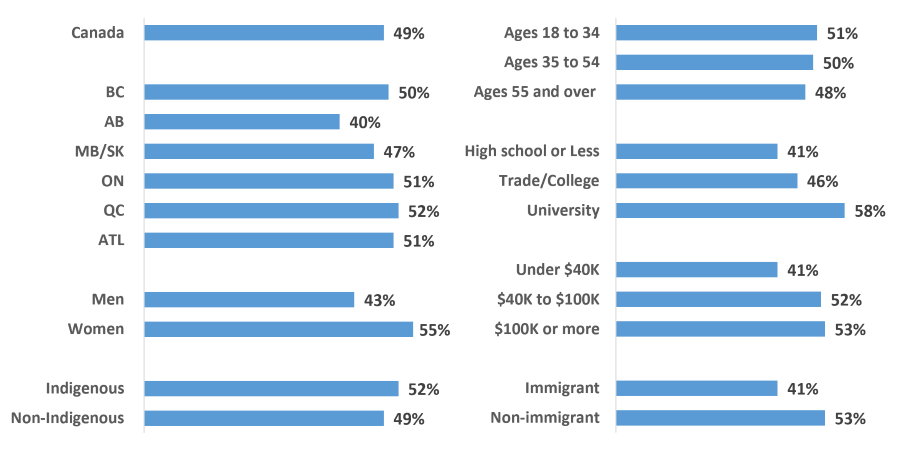
Question: To what extent do you agree or disagree with the following statements?
Questions testing Canadians' knowledge of the exemption in BC focused on:
- differences between the exemption and legalization
- the role of police in enforcing the exemption
- details about which activities involving drugs are covered by the exemption in BC
57% to 62% of Canadians, depending on the question, were able to correctly identify details of BC's exemption (Figure 4). However, 18% to 24% of respondents answered incorrectly and 15% to 19% were unsure of the answer.
Increased knowledge of the details of BC's exemption were shown by (Figure 5):
- BC respondents
- those aged 18 to 34 years
- those with higher education and income levels
- Canadian-born respondents
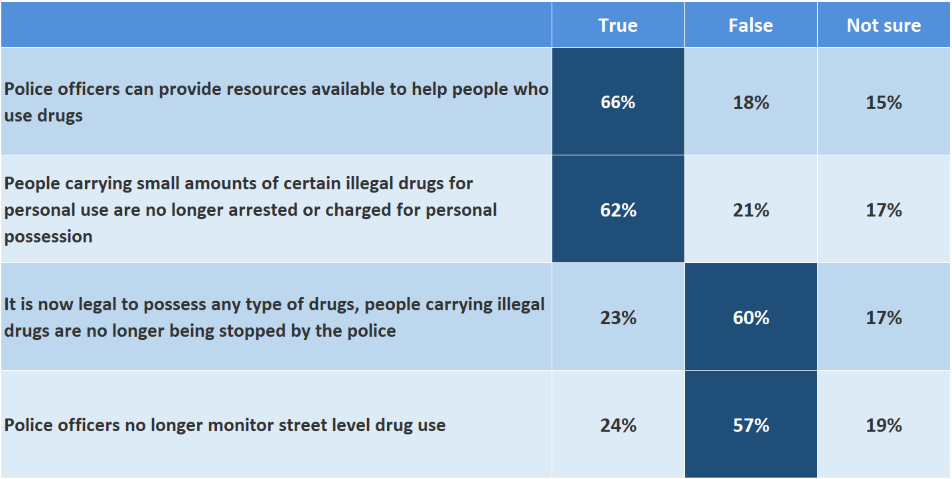
Question: Based on your understanding of the decriminalization of personal possession of drugs being implemented in British Columbia, are the following statements true or false? (Correct answers are highlighted in darker cells)
Source: PCO Survey on Current Issues, April 17 to 30, 2023
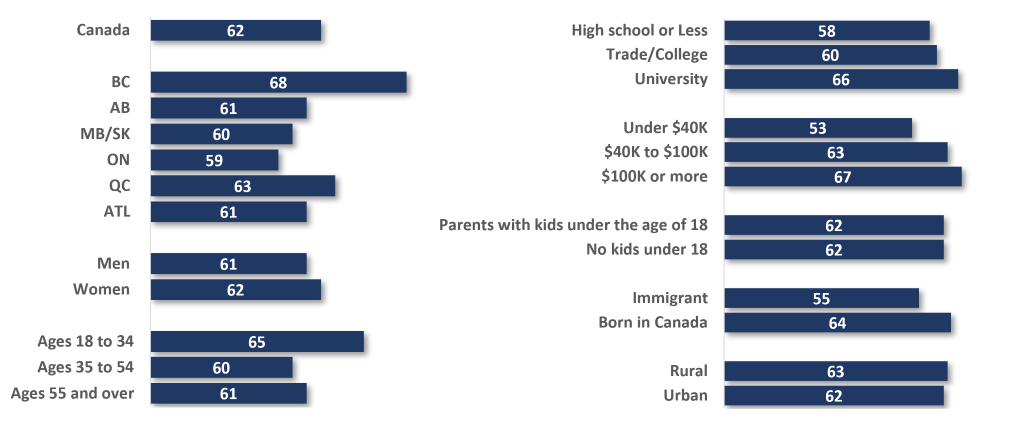
BC's exemption understanding index: Respondents get 25 points for each correct answer. A respondent who answers all four questions correctly gets a score of 100 (range: 0-100)
The results from this survey reflect the knowledge and attitudes of Canadian adults around drug decriminalization and the exemption in BC. These results will serve as a baseline to monitor key outcomes of the exemption, particularly public awareness and understanding of the details of the exemption and substance use. Health Canada's work will continue to compliment monitoring and evaluation work being led by the BC Ministry of Mental Health and Addictions and the Canadian Institutes of Health Research.
Page details
An official website of the United States government
The .gov means it’s official. Federal government websites often end in .gov or .mil. Before sharing sensitive information, make sure you’re on a federal government site.
The site is secure. The https:// ensures that you are connecting to the official website and that any information you provide is encrypted and transmitted securely.
- Publications
- Account settings
Preview improvements coming to the PMC website in October 2024. Learn More or Try it out now .
- Advanced Search
- Journal List
- v.10(9); 2020

Original research
Impact evaluations of drug decriminalisation and legal regulation on drug use, health and social harms: a systematic review, ayden i scheim.
1 Epidemiology and Biostatistics, Dornsife School of Public Health, Drexel University, Philadelphia, Pennsylvania, USA
2 Centre on Drug Policy Evaluation, St Michael's Hospital, Toronto, Ontario, Canada
Nazlee Maghsoudi
3 Institute of Health Policy, Management and Evaluation, University of Toronto, Toronto, Ontario, Canada
Zack Marshall
4 Social Work, McGill University, Montreal, Quebec, Canada
Siobhan Churchill
5 Epidemiology and Biostatistics, Western University, London, Ontario, Canada
Carolyn Ziegler
6 Library Services, Unity Health Toronto, Toronto, Ontario, Canada
7 Medicine, University of California San Diego, La Jolla, California, USA
Associated Data
bmjopen-2019-035148supp001.pdf
bmjopen-2019-035148supp002.pdf
bmjopen-2019-035148supp003.pdf
To review the metrics and findings of studies evaluating effects of drug decriminalisation or legal regulation on drug availability, use or related health and social harms globally.
Systematic review with narrative synthesis.
Data sources
We searched MEDLINE, Embase, PsycINFO, Web of Science and six additional databases for publications from 1 January 1970 through 4 October 2018.
Inclusion criteria
Peer-reviewed articles or published abstracts in any language with quantitative data on drug availability, use or related health and social harms collected before and after implementation of de jure drug decriminalisation or legal regulation.
Data extraction and synthesis
Two independent reviewers screened titles, abstracts and articles for inclusion. Extraction and quality appraisal (modified Downs and Black checklist) were performed by one reviewer and checked by a second, with discrepancies resolved by a third. We coded study-level outcome measures into metric groupings and categorised the estimated direction of association between the legal change and outcomes of interest.
We screened 4860 titles and 221 full-texts and included 114 articles. Most (n=104, 91.2%) were from the USA, evaluated cannabis reform (n=109, 95.6%) and focussed on legal regulation (n=96, 84.2%). 224 study outcome measures were categorised into 32 metrics, most commonly prevalence (39.5% of studies), frequency (14.0%) or perceived harmfulness (10.5%) of use of the decriminalised or regulated drug; or use of tobacco, alcohol or other drugs (12.3%). Across all substance use metrics, legal reform was most often not associated with changes in use.
Conclusions
Studies evaluating drug decriminalisation and legal regulation are concentrated in the USA and on cannabis legalisation. Despite the range of outcomes potentially impacted by drug law reform, extant research is narrowly focussed, with a particular emphasis on the prevalence of use. Metrics in drug law reform evaluations require improved alignment with relevant health and social outcomes.
Strengths and limitations of this study
- This is the first study to review all literature on the health and social impacts of decriminalisation or legal regulation of drugs.
- We systematically searched 10 databases over a 38-year period, without language restrictions.
- The review was limited to study designs appropriate for evaluating interventions, nevertheless, most included studies used relatively weak evaluation designs.
- Included outcomes were heterogeneous and not quantitatively synthesised.
- Heterogeneity in the details and implementation of decriminalisation or legal regulation policies was not considered in this review.
Introduction
An estimated 271 million people used an internationally scheduled (‘illicit’) drug in 2017, corresponding to 5.5% of the global population aged 15 to 64. 1 Despite decades of investment, policies aimed at reducing supply and demand have demonstrated limited effectiveness. 2 3 Moreover, prohibitive and punitive drug policies have had counterproductive effects by contributing to HIV and hepatitis C transmission, 4 5 fatal overdose, 6 mass incarceration and other human rights violations 7 8 and drug market violence. 9 As a result, there have been growing calls for drug law reform 10–12 and in 2019, the United Nations Chief Executives Board endorsed decriminalisation of drug use and possession. 13 Against this backdrop, as of 2017 approximately 23 countries had implemented de jure decriminalisation or legal regulation of one or more previously illegal drugs. 14–16
A wide range of health and social outcomes are affected by psychoactive drug production, sales and use, and thus are potentially impacted by drug law reform. Nutt and colleagues have categorised these as physical harms (eg, drug-related morbidity and mortality to users, injury to non-users), psychological harms (eg, dependence) and social harms (eg, loss of tangibles, environmental damage). 17 18 Concomitantly, a diverse and sometimes competing set of goals motivate drug policy development, including ameliorating the poor health and social marginalisation experienced by people who use drugs problematically, shifting patterns of use to less harmful products or modes of administration, curtailing illegal markets and drug-related crime and reducing the economic burden of drug-related harms. 19
Given ongoing interest by states in drug law reform, as well as the recent position statement by the United Nations Chief Executives Board endorsing drug decriminalisation, 13 a comprehensive understanding of their impacts to date is required. However, the scientific literature has not been well-characterised, and thus the state of the evidence related to these heterogeneous policy targets remains largely unclear. Systematic reviews, including two meta-analyses, are narrowly focussed on adolescent cannabis use. Dirisu et al found no conclusive evidence that cannabis legalisation for medical or recreational purposes increases cannabis use by young people. 20 In the two meta-analyses, Sarvet et al found that the implementation of medical cannabis policies in the USA did not lead to increases in the prevalence of past-month cannabis use among adolescents 21 and Melchior et al found a small increase in use following recreational legalisation that was reported only among lower-quality studies. 22
Given increasing interest in quantifying the impact of drug law reform, as well as a lack of systematic assessment of outcomes beyond adolescent cannabis use to date, we conducted a systematic review of original peer-reviewed research evaluating the impacts of (a) legal regulation and (b) drug decriminalisation on drug availability, use or related health and social harms. Our primary aim is to characterise studies with respect to metrics and indicators used. The secondary aim is to summarise the findings and methodological quality of studies to date.
Consistent with our aim of synthesising evidence on the impacts of decriminalisation and legal regulation across the spectrum of potential health and social effects, we conducted a systematic review using narrative synthesis 23 without meta-analysis. Preferred Reporting Items for Systematic Reviews and Meta-Analyses (PRISMA) guidelines were followed in preparing this manuscript. 24 The review protocol was registered in PROSPERO (CRD42017079681) and can be found online at https://www.crd.york.ac.uk/prospero/display_record.php?RecordID=79681 .
Search strategy and selection criteria
The review team developed, piloted and refined the search strategy in consultation with a research librarian and content experts. We searched MEDLINE, Embase, PsycINFO, Web of Science, Criminal Justice Abstracts, Applied Social Sciences Index & Abstracts, International Bibliography of the Social Sciences, PAIS Index, Policy File Index and Sociological Abstracts for publications from 1 January 1970 through 4 October 2018. We used MeSH (Medical Subject Headings) terms and keywords related to (a) scheduled psychoactive drugs, (b) legal regulation or decriminalisation policies and (c) quantitative study designs. Search terms specific to health and social outcomes were not employed so that the search would capture the broad range of outcomes of interest. See online supplemental appendix A for the final MEDLINE search strategy. For conference abstracts, we contacted authors for additional information on study methods and to identify subsequent relevant publications.
Supplementary data
We included peer-reviewed journal articles or conference abstracts reporting on original quantitative studies that collected data both before and after the implementation of drug decriminalisation or legal regulation. We did not consider as original research studies that reproduced secondary data without conducting original statistical analyses of the data. We defined decriminalisation as the removal of criminal penalties for drug use and/or possession (allowing for civil or administrative sanctions) and legal regulation as the development of a legal regulatory framework for the use, production and sale of formerly illegal psychoactive drugs. Studies were excluded if they evaluated de facto (eg, changes in enforcement practices) rather than de jure decriminalisation or legal regulation (changes to the law). This exclusion applied to studies analysing changes in outcomes following the US Justice Department 2009 memo deprioritising prosecution of cannabis-related offences legal under state medical cannabis laws. Eligible studies included outcome measures pertaining to drug availability, use or related health and social harms. We used the schema developed by Nutt and colleagues to conceptualise health and social harms, including those to users (physical, psychological and social) and to others (injury or social harm). 18
Both observational studies and randomised controlled trials were eligible in principle, but no trials were identified. There were no geographical or language restrictions; titles, abstracts and full-texts were translated on an as-needed basis for screening and data extraction. We excluded cross-sectional studies (unless they were repeated) and studies lacking pre-implementation and post-implementation data collection because such designs are inappropriate for evaluating intervention effects.
Data analysis
Screening and data extraction were conducted in DistillerSR (Evidence Partners, Ottawa, Ontario). We began with title-only screening to identify potentially relevant titles. Two reviewers screened each title. Unless both reviewers independently decided a title should be excluded, it was advanced to the next stage. Next, two reviewers independently screened each potentially eligible abstract. Inter-rater reliability was good (weighted Kappa at the question level=0.75). At this stage, we retrieved full-text copies of all remaining references, which were screened independently by two reviewers. Disagreements on inclusion were resolved through discussion with the first author. Finally, one reviewer extracted data from each included publication using a standardised, pre-piloted form and performed quality appraisal. A second reviewer double-checked data extraction and quality appraisal for every publication, and the first author resolved any discrepancies.
The data extraction form included information on study characteristics (author, title, year, geographical location), type of legal change studied and drug(s) impacted, details and timing of the legal change (eg, medical vs recreational cannabis regulation), study design, sampling approach, sample characteristics (size, age range, proportion female) and quantitative estimates of association. We coded each study-level outcome measure into one metric grouping, using 24 pre-specified categories and a free-text field (see figure 1 for full list). Examples of metrics include: prevalence of use of the decriminalised or regulated drug, overdose or poisoning and non-drug crime.

Metrics examined by included studies. excl., excluding.
We also categorised the estimated direction of association of the legal change on outcome measure(s) of interest (beneficial, harmful, mixed or null). These associations were coded at the outcome (not study) level and classified as beneficial if a statistically significant increase in a positive outcome (eg, educational attainment) or decrease in a negative outcome (eg, substance use disorder) was attributed to implementation of decriminalisation or legal regulation, and vice versa for harmful associations. The association was categorised as mixed if associations were both harmful and beneficial across participant subgroups, exposure definitions (eg, loosely vs tightly regulated medical cannabis access) or timeframes. Although any use of cannabis and other psychoactive drugs need not be problematic at the individual level, we categorised drug use as a negative outcome given that population-level increases in use may correspond to increases in negative consequences; we thought that this cautious approach to categorisation was appropriate given that such increases are generally conceptualised as negative within the scientific literature. For outcomes that are not unambiguously negative or positive, the coding approach was predetermined taking a societal perspective. For example, increased healthcare utilisation (eg, hospital visits due to cannabis use) was coded as negative because of the increased burden placed on healthcare systems. The association was categorised as null if no statistically significant changes following implementation of drug decriminalisation or legal regulation were detected. We set statistical significance at a= 0.05, including in cases where authors used more liberal criteria.
Quality assessment at the study level was conducted for each full-length article using a modified version of the Downs and Black checklist 25 for observational studies ( online supplemental appendix B ), which assesses internal validity (bias), external validity and reporting. Each study could receive up to 18 points, with higher scores indicating more methodologically rigorous studies. Conference abstracts were not subjected to quality assessment due to limited methodological details.
Patient and public involvement
This systematic review of existing studies did not include patient or public involvement.
Study characteristics
As shown in the PRISMA flow diagram ( figure 2 ), we screened 4860 titles and abstracts and 213 full-texts, with 114 articles meeting inclusion criteria ( online supplemental appendix C ). Key reasons for exclusion at the full-text screening stage were that the article did not report on original quantitative research (n=59) or did not evaluate decriminalisation or legal regulation as defined herein (n=23). Details of each included study are presented in online supplemental table 1 . Included studies had final publication dates from 1976 to 2019; 44.7% (n=51) were first published in 2017 to 2018, 43.9% (n=50) were published in 2014 to 2016 and 11.4% (n=13) were published before 2014.

PRISMA (Preferred Reporting Items for Systematic Reviews and Meta-Analyses) flow diagram.
Characteristics of included studies are described in table 1 , both overall and stratified by whether they evaluated decriminalisation (n=19) or legalisation (n=96) policies (one study evaluated both policies). Most studies (n=104, 91.2%) were from the USA and examined impacts of liberalising cannabis laws (n=109, 95.6%). Countries represented in non-US studies included Australia, Belgium, China, Czech Republic, Mexico and Portugal. The most common study designs were repeated cross-sectional (n=74, 64.9%) or controlled before-and-after (n=26, 22.8%) studies and the majority of studies (n=87, 76.3%) used population-based sampling methods. Figure 3 illustrates the geographical distribution of studies among countries where national or subnational governments had decriminalised or legally regulated one or more drugs by 2017.
Characteristics of studies evaluating drug decriminalisation or legal regulation, 1970 to 2018
*Combined total exceeds number of studies because some evaluated both decriminalisation and legal regulation.
†One global study and one multi-country European study including Belgium and Portugal.

Number of included studies from countries that implemented decriminalisation or legal regulation by 2017. Note: Policy changes were classified, following the review inclusion criteria, based on the implementation of a change to national or subnational law to decriminalise drug use and/or possession or to legalise at least one class of drugs. We did not evaluate the extent to which legal changes were reflected in policing and criminal justice practice. Implementation of cannabis legalisation for medical purposes only is not reflected in this map.
Study quality
Quality assessment was performed for the 93 full-length articles included in the review, excluding 21 conference abstracts ( online supplemental table 1 ). Scores ranged from 7 to 18 of 18 possible points, with a mean of 14.4 (SD=2.56). Quality scores were similar comparing US to non-US-based studies ( X =14.4 and 13.7, respectively, p=0.386) but higher for studies evaluating legal regulation ( X =14.8) versus decriminalisation ( X =12.8) (p=0.003). Study quality differed significantly (p<0.001) by the direction of the association with the outcome of interest, with higher quality scores among studies estimating mixed ( X =15.4) or beneficial ( X =15.2) versus null ( X =14.2) or harmful ( X =13.1) effects of legal change on the outcome of interest. Study quality did not appear to increase over time (eg, X =14.0 in 2014 and 14.4 in 2018).
Study outcome measures and metrics
Across 114 studies we extracted 224 outcome measures, which were coded into 32 metrics ( figure 1 ). The most common metric employed by studies was the prevalence of use of the decriminalised or legally regulated drug, which was examined in 39.5% of studies (n=45) and represented 22.3% of outcome measures (n=50). Of these studies, 13 (28.9%; 8 full-length articles and 5 abstracts) did not report any other metric 26–38 and an additional 6 studies (13.3%) reported on the prevalence of use in addition to a single drug-related perception metric (either harmfulness or availability). 39–44 The second most common metric was the frequency of use of the decriminalised or legally regulated drug (14.0% of studies, n=16) and the third was the prevalence or frequency of use of tobacco, alcohol or drugs that remained illegal (12.3% of studies, n=14). The fourth most commonly employed metric was any change in the perceived health harmfulness of using the decriminalised or regulated drug (10.5% of studies, n=12), which was assessed among adolescents or young adults in all studies except for one that assessed this metric among parents. 45
All other metrics were assessed in <10% of included studies. Health service utilisation was evaluated in 7.9% of studies (n=9) using 12 outcome measures, primarily related to emergency department visits and/or hospitalisations. Prescribed (primarily opioid) drug use and perceived availability of the decriminalised or legally regulated drug were reported in 7.0% of studies each (n=8). Overdose or poisoning by the decriminalised or regulated drug, and by other drugs (predominantly opioids), were examined in 5.3% (n=6) and 6.1% of studies (n=7), respectively. Driving while under the influence or with detectable concentrations of the decriminalised or regulated drug (cannabis) was examined in seven studies (6.1%) inclusive of eight outcome measures. Notably, one study assessed self-reported impaired driving, 46 while others assessed the proportion of fatally injured drivers screening cannabis-positive or the overall prevalence of driving with detectable tetrahydrocannabinol (THC) concentrations in blood. Remaining metrics were measured in less than 5% of studies ( figure 1 ). Some pre-specified metrics were not represented in any of the articles, including infectious disease incidence (eg, HIV, hepatitis C), environmental impacts (eg, drug production waste, discarded needles) and labour market participation.
Studies outside the US
Of the 10 studies conducted outside the USA, 6 focussed on cannabis decriminalisation. All three studies from Australia examined the prevalence of cannabis use post-decriminalisation, 31 34 47 while one also measured perceived cannabis availability. 47 Following cannabis decriminalisation, one European multi-country study including Belgium and Portugal examined the prevalence of cannabis use and uptake of cannabis-related addictions treatment 48 and one Czech study considered the age of first cannabis use. 49 An international study using United Nations Office on Drugs and Crime data from 102 countries compared availability, as reflected by cannabis seizures and plant eradication, in countries that had decriminalised cannabis versus those that had not. 50 Three non-US studies evaluated decriminalisation of all psychoactive drugs. Two studies from Portugal examined healthcare and non-healthcare costs and psychoactive drug prices, respectively. 51 52 One study from Mexico examined drug-related criminal justice involvement (arrests) and (violent) crimes. 53 Finally, a study of historic opium legalisation in China (1801 to 1902) measured the price and availability (quantity of exports) of opium before and after legalisation. 54
Impacts of decriminalisation and legal regulation
Results of individual studies are provided in online supplemental table 1 . Online supplemental table 2 tallies findings and average quality scores for each of the metrics; here we summarise findings for metrics examined in more than 5% of studies, in descending order based on the number of datapoints. Across all three substance use metrics (prevalence of use, frequency of use and use of other alcohol or drugs), drug law reform was most often not associated with use (with null findings for 48.0% to 52.4% of outcome measures falling under these metrics). With respect to change in perceived harmfulness of the decriminalised or regulated drug, mixed results were found in half of cases, with heterogeneity detected on the basis of age, gender and state. 39 43 55–57 For example, legal regulation of cannabis for medical use was associated with greater perceived harmfulness of cannabis among eighth graders but not older students in an analysis of US Monitoring the Future data 39 while a study employing US National Survey on Drug Use and Health data found greater perceived harmfulness of cannabis among young adults aged 18 to 25 but not adolescents aged 12 to 17. 57
Among nine studies that employed health service utilisation metrics, harmful effects were reported for 6 of 12 outcome measures, with increases in emergency department visits and/or hospitalisations attributed to decriminalisation or legal regulation. 58–63 However, all but one of those studies 58 assessed change over time in one jurisdiction, without a control group. Further, two studies that also examined changes in acute care use for non-cannabis drugs found reductions in those visits or admissions following cannabis decriminalisation or legal regulation. 60 64 In contrast, six of nine prescription drug use associations were beneficial, with reductions observed in rates of opioid 65–69 and other drug prescribing 70 71 attributed to legal regulation of cannabis for medical use; outcomes in this category came from studies of higher average quality ( X =16.3). Perceived availability of the decriminalised or regulated drug appeared largely unaffected by decriminalisation (null associations for five of nine outcome measures) but two studies indicated increased perceived availability of cannabis among Colorado, US, adolescents following legal regulation for adult use 72 and among adults in US states with legal regulation for medical use. 44 Across the subset of seven outcome measures for overdose or poisoning by the decriminalised or regulated drug (cannabis), in all cases an increase in calls to poison control centres or unintentional paediatric exposures was reported. 59 73–77 However, studies assessing the impacts of cannabis regulation on overdose or poisoning by drugs other than cannabis concluded that the effects were either beneficial (four outcome measures 64 76 78 79 ) or mixed/null (three outcome measures 80–82 ). Driving with detectable concentrations of THC was most often found to increase following decriminalisation or legal regulation (five of eight outcome measures; 83–87 ), but these studies were of lower average quality ( X =12.0).
Impacts of decriminalisation
Of the 19 studies evaluating impacts of decriminalisation, six measured the prevalence of use of the decriminalised drug with eight unique outcome measures. No association was detected for all but three outcomes; following cannabis decriminalisation lifetime use increased among adults in South Australia, 31 while past-month use increased among 12 th graders but not younger students in California, 56 relative to the rest of the country in both cases. After peyote use for ceremonial purposes was decriminalised in the USA in 1994, self-reported use increased among American Indians. 88 Three studies evaluated relationships between decriminalisation and drug-related criminal justice involvement in Mexico and the USA. One high-quality study found that decriminalisation positively influenced criminal justice involvement: in five US states, arrests for cannabis possession decreased among youth and adults. 89 When possession of small amounts of cannabis was decriminalised in the 1970s in Nebraska, however, the mean monthly number of arrests did not change, while cannabis-related prosecutions increased among youth. 90 In Tijuana, Mexico, decriminalisation of all drugs had no apparent impact on the number of drug possession arrests. 53 Two historical and one recent study measured healthcare utilisation. US states that decriminalised cannabis in the 1970s saw greater emergency department visits related to cannabis, but decreased visits related to other drugs. 60 In Colorado, US, decriminalisation was associated with increased emergency department visits for cyclic vomiting. 62 Addiction treatment utilisation, healthcare and non-healthcare costs, driving after use, price of drugs, availability of drugs, frequency of use, attitudes towards use and perceived harmfulness were each evaluated in only one or two studies of decriminalisation.
This systematic review identified 114 peer-reviewed publications and conference abstracts evaluating the impacts of drug decriminalisation or legal regulation from 1970 to 2018. Within this search period, 88.6% were published in 2014 or later. This rapid growth in scholarship was driven by the implementation and subsequent evaluation of cannabis legalisation in a number of US states beginning in 2012, and knowledge production will surely continue to accelerate as longer-term data become available and as other jurisdictions (eg, Canada and Uruguay) analyse the effects of recently implemented cannabis legalisation. Indeed, a first study on the impacts of cannabis legalisation on adolescent use in Uruguay was published in May 2020 (finding no impact on risk of use 91 ). The present study provides an overview of the emerging literature based on our systematic review and suggests three key patterns.
First, peer-reviewed longitudinal evaluations of drug decriminalisation and legal regulation are overwhelmingly geographically concentrated in the US and focussed on cannabis legalisation. Importantly, the lack of non-US studies evaluating legal regulation of cannabis for medical use may reflect the more tightly controlled nature of medical cannabis regulation in other countries, and thus the more limited potential for population-level effects. It is notable that decriminalisation in the absence of legal regulation was evaluated in only 18 studies (15.8%), despite being far more common globally than legal regulation. These gaps may hamper evidence-based drug law reform in countries that are less well-developed, that play a substantial role in drug production and transit or that have different baseline levels of substance (mis)use as compared with the US.
Second, prevalence of use was the predominant metric used to assess the impact of drug law reform, despite its limited clinical significance (eg, much cannabis use is non-problematic) and limited responsiveness to drug policy. This is because ecological analyses have indicated little relationship between drug policies and prevalence of use, 52 as have studies assessing within-state change in use related to legal regulation. 21 These findings are supported by the preponderance of evidence synthesised in this review, although some variation is evident in relation to the specific provisions of legal reforms (eg, liberal vs tightly regulated medical markets 92 ). Impacts of legal cannabis regulation on prevalence and frequency of use continue to be evaluated, with recent data suggesting small increases among adults, but not youth. 93 Drug policies may be more able to influence the types of drugs that people use, drug-related risk behaviours and modes of drug consumption. 94 Metrics to assess these outcomes, however, were lacking in the reviewed literature. For example, only one study (0.8%) investigated whether legal regulation of cannabis was associated with changes in the mode of cannabis consumption. 72 Although the prevalence of use was often measured alongside more clinically or socially significant metrics (eg, prevalence of substance use disorders, educational outcomes among young adults), 42.2% of studies assessing substance use prevalence included that metric alone or in combination with a single drug-related attitude metric.
Third, there was a lack of alignment between the stated policy objectives of drug law reform and the metrics used to assess its impact in the scientific literature. For instance, removal of criminal sanctions to prevent their negative sequelae is a key rationale for decriminalisation and legal regulation, 12 13 95 but only four studies (3.5%) evaluated changes in drug-related criminal justice involvement following drug law reform. Similarly. improving the physical and mental health of people who (already) use drugs is a motivation for drug policy reform but no included studies examined mental or physical health outcomes (aside from substance use disorders) in this population. As a result, there is a risk that decisions on drug policy may be informed by inappropriate metrics. Promisingly, in recent months, additional studies assessing legal regulation that employ a range of criminal justice metrics have been published. 96–98 Finally, despite ample evidence of the impact of criminalisation on infectious disease transmission and acquisition risks, 5 we found no studies evaluating the impact of decriminalisation on these outcomes.
Both the included studies and our systematic review have important strengths and limitations. To our knowledge, we conducted the first review of all global literature on decriminalisation and legal regulation and applied no language restrictions. All eligible articles identified were published in English; this may reflect a paucity of evaluation research published in other languages and/or limitations of our search strategy (eg, some non-English journals may not be indexed in the 10 databases searched). In addition, we excluded grey literature, non-original research and study designs that are not suited to evaluating policy effects (eg, cross-sectional studies), but these restrictions narrowed the geographical scope of included studies. For example, two articles on Portugal were excluded as non-original research, but nevertheless provide important insight on impacts of decriminalisation. 99 100 Despite restricting eligibility to more rigorous study designs, most included studies used relatively weaker eligible designs that are known to be vulnerable to pre-existing trends and confounding; only 22.8% and 5.3%, respectively, used controlled before-and-after or interrupted time series designs to address these threats to validity. The use of these study designs may be related to limited resources for prospective drug policy evaluations, with many studies relying on publicly available, routinely collected data. That the US is unique in the extent to which data on drug use and related harms are routinely collected helps to explain its over-representation in our review. Scoping reviews inclusive of grey literature and cross-sectional designs would be valuable for describing the full range of evaluations that have been conducted globally.
While beyond the scope of our high-level synthesis, the implementation and specific provisions of drug policies vary widely. Decriminalisation policies vary in their definitions of quantities for personal use, application of administrative penalties and the extent to which the law ‘on the books’ is reflected in policing and criminal justice practice. Indeed, in some jurisdictions with nominal decriminalisation, arrests for possession of small quantities of the decriminalised drugs remain routine. 53 Legal regulation models for cannabis are also heterogeneous. For example, policies legally regulating cannabis for medical use may or may not allow for legal dispensaries, and this provision has been shown to substantially modify the impact of legal regulation on cannabis use. 101 To the extent that individual studies employed crude exposure measures (eg, presence vs absence of a law), they may have obscured context-dependent effects of drug law liberalisation. Further, the impact of drug laws on drug use and related outcomes may be limited by a lack of public awareness of the details of local laws. 102
Our use of vote-counting in this synthesis (ie, categorising individual outcome measures as indicating beneficial, harmful, mixed/subgroup-specific or no statistically significant associations) is subject to the same limitation. Vote-counting should also be interpreted with caution in light of the heterogeneity of outcome definitions, the inherent arbitrariness of statistical significance thresholds and the key distinction between statistical and clinical significance. In addition, many included studies are evaluating the same policies (eg, cannabis legalisation in western US states), sometimes using overlapping data but drawing different conclusions based on analytical choices and timeframes. The existence of multiple datapoints for a particular outcome does not imply that the outcome has been well-studied across diverse contexts such that scientific consensus on its effects has been reached. Moreover, as illustrated by a recently published extension of the included article by Bachhuber et al , 79 multiple high-quality studies may generate results that are later revealed to be spurious as additional follow-up data become availability. Specifically, Shover et al demonstrated that the positive association reported between medical cannabis legalisation and opioid overdose mortality in 1999 to 2010 reversed direction in later years, suggesting that earlier findings of a protective effect should not be given causal interpretations. 103 This was foreshadowed in the included article by Powell et al , which found that the purportedly positive effect of medical cannabis legalisation was attenuated in 2010 to 2013. 82 This scientific back-and-forth can be expected given that most included articles are evaluating legal changes introduced rather recently, and thus are examining early impacts with limited years of follow-up. Longer-term impacts of non-medical cannabis legalisation, and how they might be influenced by increased commercialisation, are yet to be seen. 104
The findings of this review indicate a need for a broadening of the metrics used to assess the impacts of drug decriminalisation and legal regulation. Given the growing number of jurisdictions considering decriminalisation or legal regulation of psychoactive drugs, 14–16 the disproportionate emphasis on metrics assessing drug use prevalence, as well as the limited geo-cultural diversity in evaluations, are concerning. Experts have called for a more fulsome approach to evaluating drug policies in line with public health and the United Nations Sustainable Development Goals, with attention to the full breath of health and social domains potentially impacted, including human rights and social inclusion (eg, stigma), peace and security (eg, drug market violence), development (eg, labour market participation), drug market regulation (eg, safety of the drug supply) and clinically-significant health metrics (eg, drug-related morbidity). 105 Drawing on methods such as multi-criterion decision analysis, 19 the engagement of both scientists and policymakers in priority-setting may help to produce evidence that provides a more comprehensive understanding of the breadth of impacts that should be anticipated with drug law reform efforts. Funding will also be required to support rigorous prospective evaluations of legal reforms.
Supplementary Material
Acknowledgments.
The authors would like to thank Gelareh Ghaderi for assistance with screening and data extraction.
Twitter: @aydenisaac
Presented at: Presented at the International Society for the Study of Drug Policy (May 22, 2019) and the International Harm Reduction Conference (April 29, 2019).
Contributors: DW and AIS conceptualised and supervised the review. CZ designed and conducted the literature searches. AIS drafted the manuscript. SC, ZM and AIS conducted screening and data extraction. NM contributed to drafting the manuscript and developing figures. All authors contributed to interpretation of findings and revising the manuscript for important intellectual content.
Funding: This review was supported by the Canadian Institutes of Health Research (CIHR) via the Canadian Research Initiative on Substance Misuse (SMN-139150), the MAC AIDS Foundation, and the Open Society Foundations. Ayden Scheim was supported by a Canadian Institutes of Health Research Postdoctoral Fellowship. Nazlee Maghsoudi is supported by a CIHR Vanier Canada Graduate Scholarship. Dan Werb is supported by a US National Institute on Drug Abuse Avenir Award (DP2- {"type":"entrez-nucleotide","attrs":{"text":"DA040256","term_id":"79190989","term_text":"DA040256"}} DA040256 ), a CIHR New Investigator Award, an Early Researcher Award from the Ontario Ministry of Research, Innovation and Science and the St Michael’s Hospital Foundation.
Map disclaimer: The depiction of boundaries on the map(s) in this article does not imply the expression of any opinion whatsoever on the part of BMJ (or any member of its group) concerning the legal status of any country, territory, jurisdiction or area or of its authorities. The map(s) are provided without any warranty of any kind, either express or implied.
Competing interests: None declared.
Patient and public involvement: Patients and/or the public were not involved in the design, or conduct, or reporting, or dissemination plans of this research.
Patient consent for publication: Not required.
Provenance and peer review: Not commissioned; externally peer reviewed.
Data availability statement: All relevant data are contained within the article and supplementary materials.
LawNow Magazine
relating law to life
Decriminalization of Drugs in Canada: What does it mean and how would it work?
August 9, 2022 By Lee Klippenstein
Drug policy is changing in Canada, with Bill C-5 and requests for exemptions under section 56(1) of the Controlled Drugs and Substances Act .

There is a growing acknowledgement in Canada that drug use is a health issue and not a criminal justice problem. This is an important distinction given the way the opioid crisis is ravaging the Canadian population. John Cooper recently wrote an excellent piece for LawNow , which discusses the changing attitude towards drug use and decriminalization. Hopefully, he has convinced you why governments should pursue decriminalization.
I intend to use this space to explore the what and how of decriminalization in Canada. In the process, I hope the who , when , and where will also become clear.
What Does Decriminalization Mean?
When a drug is decriminalized, it means its possession is no longer a criminal act. It does not mean it is legal and anyone can buy it like a pack of cigarettes from a gas station or a bottle of vodka from a liquor store. It also does not mean the government is promoting or condoning its use. More importantly, decriminalization assists those who use drugs, not those who traffic them.
Decriminalization means that users of certain controlled substances will no longer face the criminal penalties they would have before the drug was reclassified. The goal is to reduce the burden on addicts and recreational users, while freeing up scarce justice system resources.
Practically speaking, decriminalization is an exemption from federal laws (those put in place by the Canadian government). The Criminal Code ( CC ) and the Controlled Drugs and Substances Act ( CDSA ) govern drug policy in Canada. Created by the federal government, they apply across Canada but are enforced at the provincial and municipal levels, primarily through policing. Offences under the CC and CDSA are also prosecuted through the provincially-run court systems.
Bill C-5: Proposed Federal Action
Canada is attempting to make modest moves towards reducing the criminal consequences of minor drug possession. In December 2021, the federal government introduced Bill C-5 in the legislature. If passed, Bill C-5 will amend both the CC and the CDSA in significant ways. The bill has passed through the House and is now before the Senate.
None of the changes in Bill C-5 will decriminalize any drug in the manner discussed above. Instead, the changes focus on removing certain mandatory minimum sentences for simple drug possession crimes. The changes also encourage conditional sentences and diversionary measures to address substance abuse in more appropriate ways.
Perhaps the most notable part of Bill C-5 in the context of decriminalization is the “declaration of principles” section ( 10.1 ), which will be added to the CDSA . This section states, in summary, that:
- substance abuse should be addressed primarily as a health and social issue
- interventions should aim to protect the health, dignity, and human rights of drug users
- criminal sanctions for the personal use of drugs increase the stigma of drug use and are not consistent with established public health evidence
- interventions should focus on the root causes of substances abuse, and measures should be directed towards these areas
- judicial resources should focus on offences that pose a greater risk to public safety
This federal bill does not go as far as some provinces and municipalities have requested. The proposed legislation, however, would alleviate some of the potential criminal justice issues that burden those who use these otherwise controlled substances.
How Does Decriminalization Happen?
The levels of government dealing with the immediate impacts of the opioid crisis – people dying daily – want a drug policy that goes further to address the stigma and health issues associated with drug use. Edmonton, Vancouver, and Toronto have all made requests to the federal government to decriminalize small amounts of substances such as cocaine, heroin, and fentanyl. British Columbia also made a request in November of 2021, and it is the first jurisdiction to receive an exemption.
Section 56(1) Exemptions: Municipal and Provincial Actions
For a city or province to change drug policy in its jurisdiction, it requires an exemption from federal laws under section 56(1) of the CDSA . The Minister of Health and Health Canada grants these exemptions to an individual or a group. They decide on a case-by-case basis. Exemptions have been provided for things like research on the effects of ketamine in treating depression, or as class exemptions to allow pharmacists to provide otherwise controlled substances to their patients. (This was how Methadone was prescribed for a long time, however an exemption is no longer required.)
To receive a section 56(1) exemption, Health Canada considers several factors, including:
- potential benefits
- potential risks or harms
- evidence the substance is necessary for the activity
- safeguards for the use and storage of the substance
B.C. successfully attained an exemption by providing evidence of the severity of the opioid crisis, as well as the province’s capacity to deal with decriminalization. Health Canada accepted B.C.’s plan, which included that:
- adequate social supports would be available to drug users
- law enforcement was properly trained to educate those possessing controlled substances on how to access these resources, and
- B.C. has a comprehensive monitoring system that will allow it to provide ongoing feedback about the impacts of decriminalization in real time.
What Does Decriminalization Look Like on the Ground?
In B.C., adults over the age of 18 will no longer face criminal penalties if police find them with less than 2.5 grams of any opioid, cocaine, methamphetamine, or MDMA (or any combined quantity of these four drugs). These four drugs are the ones deemed most likely to be associated with the ongoing opioid crisis.
The exemption will not apply if there is evidence the adult is using the drugs for more than personal use. It must be stressed that decriminalization in this form does nothing to shield drug traffickers. Law enforcement agents will make these determinations. They will also be trained to provide individual users with information regarding social services and health initiatives to address the underlying issues that cause substance abuse.
No one is suggesting that we turn a blind eye towards the use of controlled substances. Instead, the focus is on acknowledging that drug users are people with health issues that have already upended their lives. Rather than defaulting to prison and punishment, decriminalization initiatives allow drug users to operate with one less fear hovering over their head – that they are going to get “busted” – while also promoting ways for them to recover from their health issues.
It is unclear whether the B.C. model will apply, in its specifics at least, to any of the other jurisdictions that have requested a section 56(1) exemption. It is not even clear whether Edmonton or Toronto will receive this exemption – Health Canada must decide if these locales have met the requirements. The B.C. model does show the potential that decriminalization may hold. And if nothing else, the individuals dependent on these substances in that province will have one less concern.
More to Come
Both Bill C-5 and the requested section 56(1) exemptions suggest Canada may be on its way to a more progressive drug policy, which understands the drug user’s struggle as its starting point. There is likely much more to come on this topic in the coming months and years.
Looking for more information?
- Defending the Defence by Melody Izadi May 14, 2024
- Canada is not yet Ready to Expand its Medical Assistance in Dying Legislation by Myrna El Fakhry Tuttle March 18, 2024
- Accessing the Justice System: Specialized support is critical for sexual violence survivors by Lisa Oracheski February 28, 2024
The information in this article was correct at time of publishing. The law may have changed since then. The views expressed in this article are those of the author and do not necessarily reflect the views of LawNow or the Centre for Public Legal Education Alberta.
Looking for articles like this one to be delivered right to your inbox?
Lee is a law student at the Faculty of Law, University of Alberta and a volunteer with Pro Bono Students Canada.

Drug and Alcohol Testing Association of Canada
1 (866) 324-7093, call us now, understanding decriminalization and the steps to ending the opioid crisis.
Aug 3, 2021

Opinion: Decriminalization is a critical step in curbing the opioid crisis
A recent opinion article published in The Conversation examines the benefits of drug decriminalization, as well as its potential impact in fighting the ongoing opioid crisis. The article, co-authored by Alissa Greer, Assistant Professor in the School of Criminology, Simon Fraser University and Caitlin Shane, staff lawyer at Pivot Legal Society, also critically examines drug decriminalization compared to regulation, as well as its effects on drug-related harms.
According to a survey conducted in 2020, 59% of respondents favour the decriminalization of drugs. The Canadian Association of Chiefs of Police has also recently publicly supported decriminalization, in addition to British Columbia’s chief public health officer.
Earlier in 2021, the City of Vancouver submitted an application to Health Canada for an exemption from Canada’s Controlled Drugs and Substances Act — a policy reform referred to as the Vancouver Model of decriminalization.
What is drug decriminalization?
Drug decriminalization refers to the implementation of an alternative response to criminal penalties for simple possession. It has been shown that criminalization of drugs has resulted in significant health, social and economic harms to vulnerable populations, including individuals who are homeless, have mental health issues, and Indigenous individuals.
In addition, drug decriminalization aims to “minimize the contact between people who use drugs and the criminal justice system and may increase their connection to health and social systems,” according to the authors of the opinion article.
Decriminalization vs. regulation
Legal regulation of drugs involves rules to control access to drugs, in contrast to a free market or full legalization.
Since decriminalization does not promote a “safer supply” of drugs, it will not affect the illegal supply of drugs containing toxic adulterants. Finally, the illegal drug market will continue to be criminalized following the implementation of decriminalization. According to the authors of the opinion article, the overdose risk will, nevertheless, remain high.
Advantages of drug decriminalization
One of the main benefits of drug decriminalization is that it will help to address drug use as a health and social issue in contrast to a criminal one; this would reduce the workload for the legal system, as well as the costs involved. Drug decriminalization also creates a positive impact in people’s lives, promoting their opportunities to access employment and housing. Furthermore, it reduces the stigma associated with drug use, and can serve as an effective harm reduction measure. Finally, implementation of drug decriminalization can encourage people to contact emergency services following an overdose, since fear of police can act as a deterrent in some situations.
Ontario’s mayors have called for decriminalization
Ontario’s Big City Mayors (OBCM) have been calling for the decriminalization of illicit drugs, in addition to continued funding and development of mental health crisis response units.
“While the provincial government is responsible for funding and coordinating mental health and addictions supports, all levels of government have a role to play in improving services for our residents,” OBCM said.
“The war on drugs isn’t working,” said Barrie Mayor Jeff Lehman. “We need to start understanding that this is a public health crisis for people who are addicted and to take a health approach to the people who are using drugs rather than policing.”
Decriminalization as a critical step, but not a solution to opioid crisis
According to the authors of the opinion article, decriminalization is not “a standalone solution to the harms of drug prohibition.” However, it can serve as a critical step in the right direction, since it will exert a positive impact on the lives of numerous people who are harmed daily from criminalization.
The authors maintain that it is important to be aware of the limitations of decriminalization models, so that governments and other stakeholders can refocus efforts on creating a safer drug supply. The authors also emphasize the fact that decriminalization must be coupled with greater access to safer pharmaceutical alternatives to the toxic and illegal drug market.

Parental monitoring can reduce teen substance and alcohol use: Study
May 31, 2024

Study shows over 321,000 U.S. children have lost a parent to drugs
May 28, 2024
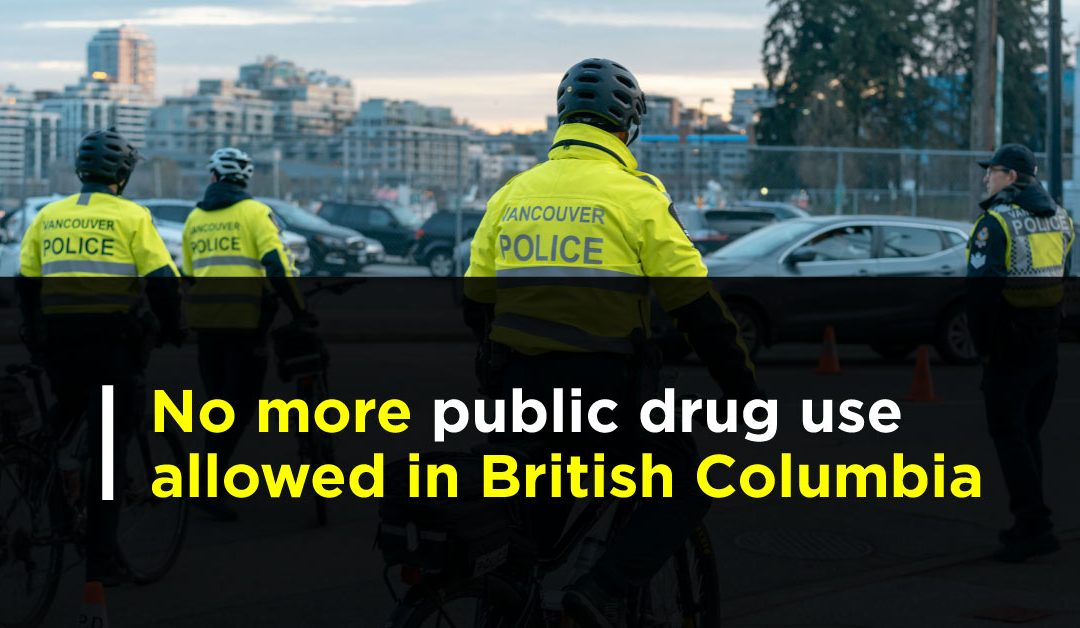
Public drug use now prohibited in British Columbia
May 24, 2024
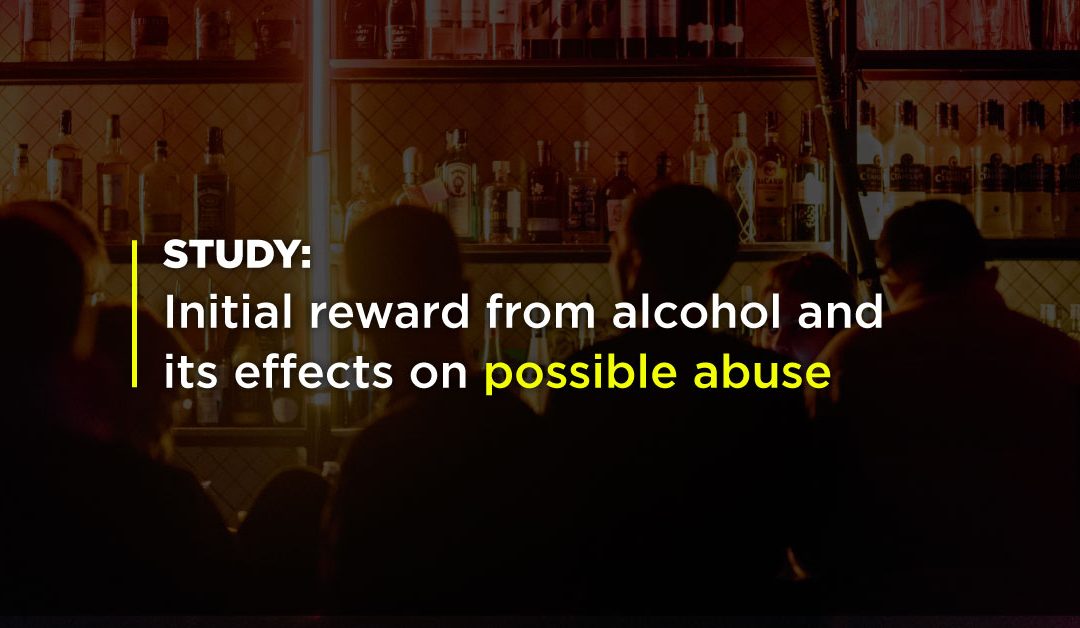
Sensitivity to alcohol’s rewarding effects increases with age: New study
May 21, 2024

Having one drink a day increases risk of alcohol use disorder: Study
May 16, 2024
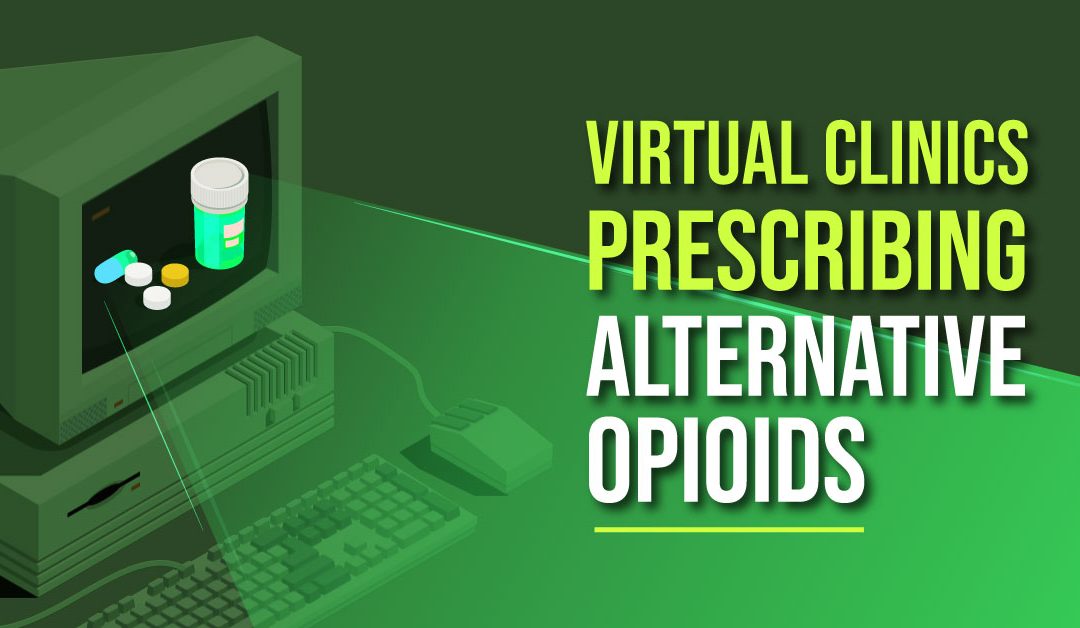
Virtual clinics now prescribe safer-supply drugs as opioid crisis escalates
May 14, 2024
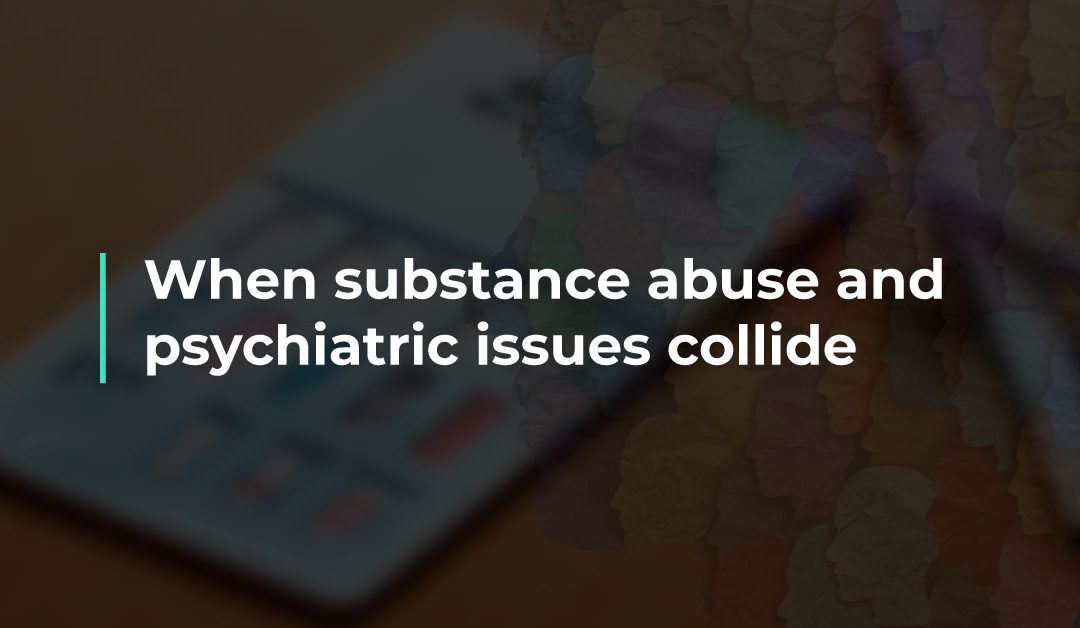
The link between mental health illness and substance use disorder : Opinion
May 10, 2024
Should Drugs Be Decriminalized in Canada? Research Paper
- To find inspiration for your paper and overcome writer’s block
- As a source of information (ensure proper referencing)
- As a template for you assignment
In response to serious opioid issues, Canada decided to introduce the decriminalization of the possession of heavy drugs in its particular territories. According to the government, this measure will help release the burden of the justice system and concentrate on health and the ways of its promotion within the framework of the prevention of drug use. Analyzing the rationale of this decision, this work aims to provide arguments against it. In other words, the decriminalization of heavy drugs is an inefficient measure for the prevention of their use as it deals with the consequences of this issue rather than its major causes, such as inadequate health practices, poor education, and economic and social inequities.
The growing rates of opioid use disorder (OUD) and the number of opioid-related deaths have become one of the most disturbing issues in the healthcare system of Canada. According to Belzak and Halverson, “while the opioid crisis has affected every region of the country, western Canada (British Columbia and Alberta) and the northern territories (Yukon and Northwest Territories) have experienced the highest-burden” (224). In British Colombia, probably the most affected province, in 1993, the number of opioid-related deaths did not exceed 330; however, in 2017, there was an increase of 400% with 1473 deaths (Fischer et al. 81). In response to this devastating situation, the government decided to focus on health care excluding opioid-related problem from the competency of the justice system.
Thus, starting January 31, 2023, an exemption from the Controlled Drugs and Substances Act will be implemented in British Colombia for three years. According to it, individuals (18 years and older) “will not be arrested or charged for possessing small amounts of certain illegal drugs for personal use. The total amount of illegal drug(s) must be equal to or less than 2.5 grams” (British Colombia par. 5).
These drugs include opioids, methamphetamine, cocaine, and MDMA; at the same time, their traffic, purchasing, and use in public places remain illegal. According to lawmakers, the criminalization of these drugs’ possession cannot improve the problem associated with opioid misuse. Moreover, it contributes to more negative consequences – the legal punishment of drug users will not prevent them from drug misuse. However, incarceration and its consequences may create additional social issues.
At the same time, the analysis of the situation shows multiple factors that should be addressed in order to minimize the rates of opioid misuse rather than deal with its consequences. Thus, according to Fischer et al., in the 1990s, “overdose deaths were primarily from combined heroin and cocaine injecting” of drug users with HIV (81). However, later, Canada increased the prescription of opioids and other heavy drugs for medical use, implementing and expanding opioid substitution treatment and supervised consumption sites. That is why “since the early 1980s, the volume of opioids sold to hospitals and pharmacies for prescriptions in Canada has increased by more than 3000%” (Belzak and Halverson 225). At the same time, the organization of research and investments in medical science for the identification or creation of safer substituents of opioids for patients with cancer or mental health issues could minimize the prescription of opioids and their potential misuse.
While the decriminalization of opioid use aims to promote safe supply and decrease the popularity of the illegal market, medical prescription does not prevent non-patients from drug abuse. There are multiple routes of opioid supply for non-medical use, including prescription-related fraud and forgery, “double doctoring,” Internet purchases, robberies and thefts, and street drug markets. In addition, according to Health Canada, “the most common source of opioids used without a prescription was a family member” – in other words, prescribed opioids may be shared among relatives (Belzak and Halverson 225). In addition, the mixing of drugs and alcohol consumption is an additional factors in opioid-related deaths. In turn, the education of citizens, along with the spread of awareness related to the negative consequences of drug use, could prevent its potential misuse in non-patients.
Finally, opioid misuse is connected with other serious social issues, such as racism, discrimination, and poverty. As multiple research states, homeless individuals and “First Nations populations across the country are heavily impacted by high rates of problematic substance use” (Belzak and Halverson 226). In addition, adolescents are highly vulnerable to opioid misuse as well. In these cases, addiction and associated consequences are caused by economic, educational, and employment issues, along with the stigmatization of asking for help and the absence of reliable assistance. In other words, due to structural racism connected with unemployment, poverty, unavailability of health care, mental health illnesses, and the absence of culturally competent health care providers, people are involved in drug use and potential misuse. Thus, paying attention to other social issues for the improvement of people’s welfare may prevent opioid issues more efficiently than drug decriminalization.
All in all, it is possible to say that the idea of help as the basis of decriminalization may be regarded as right – the punishment of drug users may create more challenges than solve the problem of drug misuse. However, it is not efficient as it does not address the main factors of drug misuse, including social, educational, health care, and economic issues that exist in society. In turn, the improvement of people’s well-being, the spread of awareness concerning the harmful effects of drugs for non-patients, and the absence of stigmatization of their medical use will genuinely decrease the seriousness of the current situation.
Works Cited
Belzak, Lisa, and Jessica Halverson. “Evidence Synthesis-The Opioid Crisis in Canada: A National Perspective.” Health Promotion and Chronic Disease Prevention in Canada: Research, Policy and Practice , vol. 38, no. 6, 2018, pp. 224-233.
British Colombia. “ Decriminalizing People Who Use Drugs in B.C. ” British Colombia . 2022. Web.
Fischer, Benedikt, et al. “The Opioid Death Crisis in Canada: Crucial Lessons for Public Health.” The Lancet Public Health , vol. 4, no. 2, 2019, pp. 81-82.
- Marijuana Legalization and Issues to Consider
- Marijuana Legalization: Chronic Seizure Treatment
- The Fentanyl Crisis in Missouri
- Alcoholism and Treatment Options
- A Human Services Organization's Prevention Program
- Understanding and Addressing Alcohol Dependence
- Advocacy Programs to Address Disparities in Mental Health and Addiction Management
- Teen Vaping: The New Wave of Nicotine Addiction
- Chicago (A-D)
- Chicago (N-B)
IvyPanda. (2023, December 13). Should Drugs Be Decriminalized in Canada? https://ivypanda.com/essays/should-drugs-be-decriminalized-in-canada/
"Should Drugs Be Decriminalized in Canada?" IvyPanda , 13 Dec. 2023, ivypanda.com/essays/should-drugs-be-decriminalized-in-canada/.
IvyPanda . (2023) 'Should Drugs Be Decriminalized in Canada'. 13 December.
IvyPanda . 2023. "Should Drugs Be Decriminalized in Canada?" December 13, 2023. https://ivypanda.com/essays/should-drugs-be-decriminalized-in-canada/.
1. IvyPanda . "Should Drugs Be Decriminalized in Canada?" December 13, 2023. https://ivypanda.com/essays/should-drugs-be-decriminalized-in-canada/.
Bibliography
IvyPanda . "Should Drugs Be Decriminalized in Canada?" December 13, 2023. https://ivypanda.com/essays/should-drugs-be-decriminalized-in-canada/.
Gov't polling showed many Canadians' drug decriminalization fears
2023 survey suggested canadians are split over whether decriminalization would make communities less safe.

Social Sharing
Months before British Columbia sought to scale back its drug decriminalization pilot project, the federal government's own polling suggested to officials that a majority of Canadians believed the policy would lead to an increase in overdoses.
The results of the 11-page survey by the Privy Council Office, the wing of federal bureaucracy that supports the Prime Minister's Office, also suggests Canadians were split over whether decriminalization would make their community any less safe.
"I guess what people are thinking is that [decriminalization] will somehow enable drug use," said Thomas Kerr, a professor and head of the division of social medicine at the University of British Columbia and the director of research at the B.C. Centre on Substance Use.
Similar opinions were expressed over supervised drug consumption sites and even needle exchanges, Kerr said, adding that fears they would lead to increased use didn't play out "in reality."
"People have really overestimated the impacts of decriminalization, both positive and negative," he said.
- British Columbia to recriminalize use of drugs in public spaces
Decriminalization has grown into a political lightning rod over recent weeks after the B.C. NDP government reversed course and asked that police again be empowered to arrest people or seize illicit drugs when they are being used in public spaces.
The move followed months of concern over public drug use, including inside hospitals.
The federal Conservatives have seized on the issue and pressed Prime Minister Justin Trudeau's Liberals to rule out granting a federal exemption to any other jurisdictions wishing to pursue decriminalization programs in an effort to curb opioid deaths.
Opposition Leader Pierre Poilievre describes the policy as the legalization of hard drugs.
Federal Mental Health and Addictions Minister Ya'ara Saks has defended the decision to allow B.C.'s pilot project as one tool to combat the overdose crisis, which she says is being fuelled by an increasingly toxic drug supply.
She recently rejected Toronto's longstanding application to undertake a similar program, telling The Canadian Press it was because its application lacked limits on the amount of drugs an individual could possess and any age restrictions.
There is currently no new application from the city or from places like Halifax or Montreal, Saks recently told the House of Commons after being pressed by the Tories.
"People are dying because of street drugs; they are not dying because of decriminalization," Saks said.
More than 40,000 people have died from opioid-related deaths since 2016, which is when Health Canada started tracking what Kerr called "Canada's worst public health crisis in modern history."
B.C. became the first jurisdiction in Canada to pilot the decriminalization of small quantities of illicit drugs like heroin, fentanyl, cocaine and MDMA, for three years beginning in January 2023. The province has long been ground zero for the country's overdose crisis.
- Ottawa approves B.C.'s request to recriminalize use of illicit drugs in public spaces
Officials and others promoting decriminalization say it is meant to be a way to reduce stigma for drug users and try to get them connected to help, instead of sitting in jail.
Survey results
In the weeks after the pilot launched, the federal government decided to poll Canadians on their attitudes about decriminalization and drug use in general.
Health Canada published the survey's findings last fall on a section of the government's website containing infographics, bulletins, advisories and other publications on health-related issues.
The Privy Council Office surveyed two random samples of 2,000 Canadians early last year.
It found that 49 per cent of respondents said they preferred focusing on health and social services when it came to addressing substance use among drug users, as opposed to 35 per cent who felt there was also a role for police.
While women and those with higher incomes tended to favour a health-focused approach, the findings suggested men and lower-income earners were more likely to prefer a police response.
It noted that "Canadian born respondents" were also more likely to favour a health approach, while immigrants were more likely to see room for police.
- Toronto decriminalization pitch left addictions minister with 'deep concerns'
When it comes to the issue of decriminalization, the survey found that 51 per cent of respondents agreed with the statement, "I believe decriminalizing drugs would increase harms associated with drug use such as overdoses."
That is compared to 38 per cent who said they disagreed and seven per cent who said they neither agreed nor disagreed.
Related Stories
- Top stories from British Columbia
- B.C. NDP well ahead of its rivals, poll suggests
- Martial arts lawsuit defendants deny fault for man's brain injury
- Warden told to justify killer's prison transfer for drug dealing
- Where to Find Us
- Submit News Tip
- Advertise With Us
- Newsletters
- News Insiders
Polling said Canadians worried about drug decriminalization, UBC prof. says it’s ‘overestimated’

By Stephanie Taylor, The Canadian Press
Posted May 31, 2024 1:00 am.
Last Updated May 31, 2024 6:40 am.
Months before British Columbia sought to scale back its drug decriminalization pilot project, the federal government’s own polling suggested to officials that a majority of Canadians believed the policy would lead to an increase in overdoses.
The results of the 11-page survey by the Privy Council Office, the wing of the federal bureaucracy that supports the Prime Minister’s Office, also suggests Canadians were split over whether decriminalization would make their community any less safe.
“I guess what people are thinking is that (decriminalization) will somehow enable drug use,” said Thomas Kerr, a professor and head of the division of social medicine at the University of British Columbia and the director of research at the B.C. Centre on Substance Use.
Similar opinions were expressed over supervised drug consumption sites and even needle exchanges, Kerr says, adding that fears they would lead to increased use didn’t play out “in reality.”
He also said: “People have really overestimated the impacts of decriminalization, both positive and negative.”
Decriminalization has grown into a political lightning rod over recent weeks after the B.C. NDP government reversed course and asked that police again be empowered to arrest people or seize illicit drugs when they are being used in public spaces.
The move followed months of concern over public drug use, including inside hospitals.
The federal Conservatives have seized on the issue and pressed Prime Minister Justin Trudeau’s Liberals to rule out granting a federal exemption to any other jurisdictions wishing to pursue decriminalization programs in an effort to curb opioid deaths.
Opposition Leader Pierre Poilievre describes the policy as the legalization of hard drugs.
Federal Mental Health and Addictions Minister Ya’ara Saks has defended the decision to allow B.C.’s pilot project as one tool to combat the overdose crisis, which she says is being fuelled by an increasingly toxic drug supply.
She recently rejected Toronto’s longstanding application to undertake a similar program, telling The Canadian Press it was because its application lacked limits on the amount of drugs an individual could possess and any age restrictions.
There is currently no new application from the city or from places like Halifax or Montreal, Saks recently told the House of Commons after being pressed by the Tories.
“People are dying because of street drugs; they are not dying because of decriminalization,” Saks said.
More than 40,000 people have died from opioid-related deaths since 2016, which is when Health Canada started tracking what Kerr called “Canada’s worst public health crisis in modern history.”
B.C. became the first jurisdiction in Canada to pilot the decriminalization of small quantities of illicit drugs like heroin, fentanyl, cocaine and MDMA, for three years beginning in January 2023. The province has long been ground zero for the country’s overdose crisis.
In the weeks after the pilot launched, the federal government decided to poll Canadians on their attitudes about decriminalization and drug use in general.
Health Canada published the survey’s findings last fall on a section of the government’s website containing infographics, bulletins, advisories and other publications on health-related issues.
The Privy Council Office surveyed two random samples of 2,000 Canadians early last year.
While women and those with higher incomes tended to favour a health-focused approach, the findings suggested men and lower-income earners were more likely to prefer a police response.
It noted that “Canadian born respondents” were also more likely to favour a health approach, while immigrants were more likely to see room for police.
When it comes to the issue of decriminalization, the survey found that 51 per cent of respondents agreed with the statement, “I believe decriminalizing drugs would increase harms associated with drug use such as overdoses.”
That is compared to 38 per cent who said they disagreed and seven per cent who said they neither agreed nor disagreed.
The survey results suggest a majority believe decriminalization would make accessing services like recovery and treatment easier. A majority also said they have empathy for those struggling with drug addiction.
Still, 43 per cent of respondents said they agreed it would make their community less safe, compared to 46 per cent who disagreed. Another eight per cent didn’t answer.
Saks’s office highlighted the finding that suggests people empathize with those struggling and believe decriminalization will make supports easier to access.
“From the outset we’ve been clear, the exemption would be rigorously monitored, evaluated and adapted as needed, guided by the dual objectives of public health and public safety,” it said in an email.
“We are focused on ensuring people who use drugs can be moved from the criminal justice system to the healthcare system.”
Kerr said while he believes there is room for public education when it comes to specific harm-reduction policies, it would be “highly irresponsible” for policy-makers to base decisions around public sentiment.
Nonetheless, he said it appears “the pendulum is swinging” and the country is experiencing a “right-wing” backlash against certain drug policies.
That includes not just decriminalization of possession but also the provision of pharmaceutical alternatives for drug users in an effort to keep them away from toxic drugs — an approach known as safe supply.
Poilievre has taken specific aim at such programs, promising that a future Conservative government would place greater focus on treatment and recovery options.
“The question always becomes, what do you do for people when they’re not in treatment, or whether they’ve just left a treatment program and have relapsed,” Kerr said.
“We need to keep these people alive and disease free, and living with some dignity.”
Top Stories

A search is underway for three missing mountaineers north of Squamish.
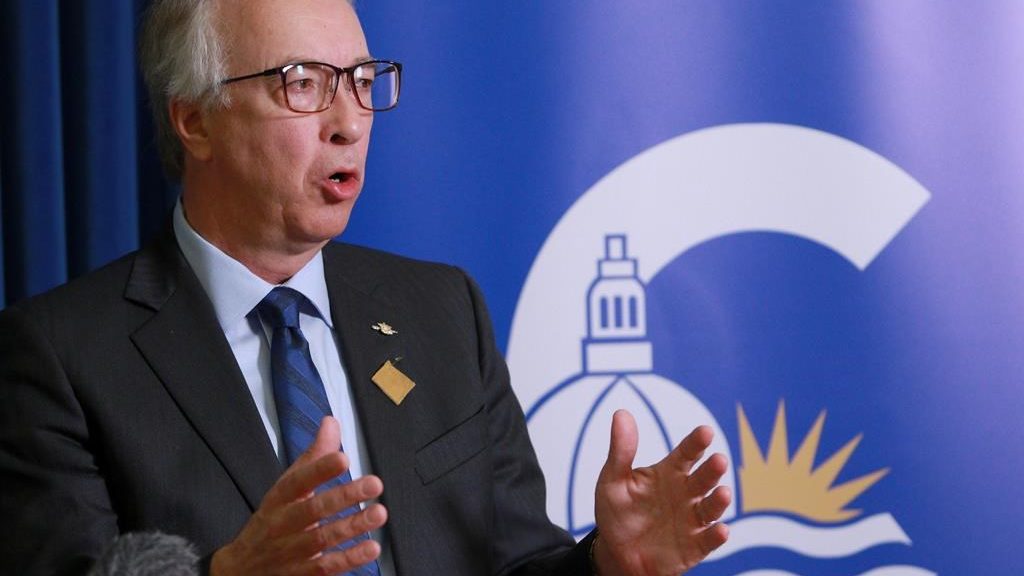
In today’s The Big Story podcast, it's been decades since the Conservative Party played any real role in British Columbia's legislature. But that might be changing. With a little over four months until...
The Big Story

As of June 1, the province's minimum wage has gone from $16.75 to $17.40 per hour, while Metro Vancouver’s living wage is over $25 per hour.

Coquitlam Search and Rescue (SAR) came to the aid of a kayaker with a broken ankle on Twin Islands Sunday, CityNews has learned.
Most Watched Today

As of June 1, B.C.'s minimum wage has gone from $16.75 to $17.40 per hour, while Metro Vancouver’s living wage is over $25 per hour. Is this enough to keep low paid workers afloat in one of the most expensive cities in the nation?

Weather experts are forecasting a hot summer in B.C., with temperatures expected to rise next week. The province is taking steps to plan ahead, including more access to air conditioners as well as protections for seniors.

More Canadians will be covered by the NDP's dental care plan, starting in June

Convicted B.C. serial killer Robert Pickton has died. The news brings a mix of emotions to the families of his victims.

As magic mushroom stores pop up around the province, there's a constitutional challenge at Ontario court that seeks to remove psilocybin from the list of controlled substances. Xiao Li reports.
Adjust preferences
With your consent we may collect cookies and information to enhance our service, and improve your experience.
These cookies and data are essential for browsing our website and allowing services. Examples include, session, authentication, and security cookies.
These cookies and data enable the website to provide enhanced functionality and personalized content.
These cookies and data inform us which pages are most informative and engaging via analytics.
These cookies may track data across websites for marketing and interest-based advertising to provide personalized content, offers, and advertisements.

Ford calls drug decriminalization a ‘nightmare’ that will ‘never’ happen in Ontario
Drug decriminalization is an “absolute nightmare” that will “never” happen under Ontario's Progressive-Conservative government, Premier Doug Ford says.
Ford made the comments to reporters on Friday amid a national debate over the policy, which was recently rejected in Toronto by the federal government.
“It's an absolute nightmare. It would be a disaster,” Ford said.
“As long as I'm premier, we're never going to decriminalize hardcore drugs.”
Ford cited British Columbia as an example, which recently recriminalized the use of drugs in public places following a pilot project that sparked public and political blowback.
British Columbia’s pilot project began in January 2023, but this spring's reversal came after B.C. Premier David Eby expressed concerns about an “escalating situation” regarding public safety. This January, B.C. chief coroner reported a new record high in overdose deaths for 2023, the first year of decriminalization: at least 2,511 lives lost.
Eby said that escalating situation included concerns about drug use in hospitals, and public places like restaurants. He concluded the changes were needed after the attorney general said a legal battle over the province’s own attempt to legislate restrictions on public drug use could be tied up in court for at least a year.
“Addiction is a health issue, it is not a criminal law issue, and that principle is what the entire decriminalization project was about,” Eby said.
“But that compassion, that concern for people who are struggling does not mean that anything goes. We still have expectations around safety, public spaces, in the coffee shop, on the bus, in the park, on the beach.”
Ford praised Eby on Friday, saying he was “so proud” of the premier for reversing that “big mistake.”
He also thanked Ottawa for “giving the jurisdiction of that into the hands of the province.” The federal government recently rejected a request from Toronto to decriminalize the possession of small quantities of drugs for personal use.
More on Politics
- Canada will reinstate citizenship rights to ‘lost Canadians’
- Competition Bureau probing conduct of Loblaws, Sobeys owners. Why?
- U.S. senators urge Trudeau to meet NATO’s 2% defence spending target
“What I believe in: we need more detox centres (and) we need more rehabilitation centres,” Ford said.
“But we sure the heck don't need people shooting up and doing drugs in neighbourhoods like Etobicoke, Mississauga or anywhere in that case in Ontario.”
The Canadian Press reported Friday that Federal Addictions Minister Ya’ara Saks had “deep concerns” about the lack of limits Toronto put on its now-rejected pitch to decriminalize the possession of illegal drugs.
Saks said the proposal did not include age restrictions or limits on the amount of drugs a person could have in their possession.
Saks added she made the decision to refuse the pitch after she received word Toronto would not amend its plans to address the concerns raised earlier by department officials.
Video: Opioid crisis: Are Canada’s ‘safe supply’ drugs being used in organized crime?
A Toronto Public Health spokesperson did not answer questions about the minister’s description of her objections, or the timeline of events, but added decriminalization is but one “evidence-informed policy tool to help remove barriers to care.”
Ontario did not support Toronto’s pitch; it warned Toronto Public Health to drop its more than two-year-old decriminalization application.
Ford also wrote a letter recently to Prime Minister Justin Trudeau asking Ottawa to stop approving new sites that supply safe opioids, while seeking a review of the Health Canada-approved sites across the country.
-- with files from Global News’ Sean Boynton , Simon Little and The Canadian Press

If Canada wants to know what decriminalization looks like without a safe supply of drugs, it only needs to look about 600 kilometres south of the border. ... Since then, deaths have continued to ...
The most recent data shows there were over 48,000 drug-related offences in Canada in 2019, ... Unlike legal frameworks applied to the supply of drugs, decriminalization does not promote a "safer ...
Since 2016, more than 10,300 Canadians have died of an apparent opioid-related overdose, with the majority involving fentanyl or fentanyl analogs.1 This unprecedented public health crisis has decreased life expectancy at birth in the country's most affected provinces of Alberta and British Columbia.2 Concerned by this epidemic of overdoses, Canadian advocates for drug policy reform have ...
Decriminalizing drugs is not intended as a solution to drug problems. Rather, it is a critical first step that's necessary, but not sufficient, for replacing prohibition with a public health ...
As the opioid crisis continues across Canada, it is anticipated more Chiefs of Police will be asked for comment on the crisis and their position regarding decriminalization of illicit drugs. This topic has the potential to be a polarizing issue between enforcement and health sectors. Decriminalization is also
risk populations, particularly people who use drugs.9 As a result, Canada has experienced a dramatic rise in fatal and non-fatal overdoses resulting from an increasingly toxic illicit drug supply. Importantly, the negative effects of the COVID-19 pandemic will persist for years to come.
The statistics are compiled by Health Canada's Drug Analysis Service (DAS), which tests approximately 125,000 samples of drugs apprehended by the Canada Border Services Agency, the Correctional ...
Decriminalization is an evidence-based policy strategy to reduce the harms associated with the criminalization of illicit drugs. For those who use illicit drugs, these harms include criminal records, stigma, high-risk consumption patterns, overdose and the transmission of blood-borne disease.
2020. This letter to Canada's Minister of Health, Minister of Public Safety and Emergency Preparedness and Minister of Justice and Attorney General of Canada asks for the immediate decriminalization of simple drug possession in Canada by issuing a federal exemption to all people in Canada from section 4(1) of the CDSA.
governed drug policy in Canada since the 1900's serves to eliminate the use of illicit substances through a process of enforcement and criminalization (Malleck 220). This framework was ... we can work towards a decriminalization and harm-reduction framework that supports those with addictions, an approach that does not marginalize ...
Examines the various options and evidence on the decriminalization of controlled substances as a means to reduce harms. Based on Canadian and international research, this policy brief notes that recognizing that substance use is a health, rather than a criminal justice, issue is a starting point for reform. Describes how decriminalization covers a range of policies and practices.
Approach to monitoring attitudes around drug decriminalization. Health Canada is collecting data at a national level on Canadians' attitudes towards, and knowledge of, drug decriminalization. To do this, Health Canada has identified a set of indicators to monitor changes related to: stigma; attitudes towards drug use; perceptions of public safety
The push comes as overdose deaths are hitting new highs in much of the country, in part fuelled by an increasingly toxic illegal drug supply and, advocates say, by the social isolation and stress ...
Introduction. An estimated 271 million people used an internationally scheduled ('illicit') drug in 2017, corresponding to 5.5% of the global population aged 15 to 64. 1 Despite decades of investment, policies aimed at reducing supply and demand have demonstrated limited effectiveness. 2 3 Moreover, prohibitive and punitive drug policies have had counterproductive effects by contributing ...
For many, the primary barrier to decriminalization and wider drug policy reform was the lack of political will within Canadian politics. This lack of political will was highlighted when comparing the government's actions in response to COVID-19 versus those in addressing Canada's ongoing drug toxicity crisis:
Practically speaking, decriminalization is an exemption from federal laws (those put in place by the Canadian government). The Criminal Code (CC) and the Controlled Drugs and Substances Act (CDSA) govern drug policy in Canada. Created by the federal government, they apply across Canada but are enforced at the provincial and municipal levels ...
There are three main legal approaches to drugs:1. • Criminalization - personal use, possession, production and sale of drugs is illegal (e.g. heroin, cocaine). • Decriminalization - personal use and possession of drugs is allowed, but production and sale is illegal (no examples in Canada). • Regulation - use of drugs is legal, and ...
Media, policy-makers, advocates and the public claim that decriminalization will make drug use safer and save lives.But can it? Decriminalization has been somewhat of a policy buzzword in recent years, with ample media coverage.It comes with both public and government support. A 2020 survey of more than 5,000 Canadians showed that the majority (59%) favour the decriminalization of drugs.
Opinion: Decriminalization is a critical step in curbing the opioid crisis. A recent opinion article published in The Conversation examines the benefits of drug decriminalization, as well as its potential impact in fighting the ongoing opioid crisis. The article, co-authored by Alissa Greer, Assistant Professor in the School of Criminology, Simon Fraser University and Caitlin Shane, staff ...
In response to serious opioid issues, Canada decided to introduce the decriminalization of the possession of heavy drugs in its particular territories. According to the government, this measure will help release the burden of the justice system and concentrate on health and the ways of its promotion within the framework of the prevention of ...
Good Essays. 1619 Words. 7 Pages. Open Document. Decriminalization of drugs is not the same thing as legalization, not endorsing the use of drugs but instead attempting a different approach at the stop of drug use. Drug dealers and manufacturers are still incarcerated, while drug addicts are given treatment instead of punishment.
B.C. became the first jurisdiction in Canada to pilot the decriminalization of small quantities of illicit drugs like heroin, fentanyl, cocaine and MDMA, for three years beginning in January 2023.
The results of the 11-page survey by the Privy Council Office, the wing of the federal bureaucracy that supports the Prime Minister's Office, also suggests Canadians were split over whether decriminalization would make their community any less safe. "I guess what people are thinking is that (decriminalization) will somehow enable drug use ...
Decriminalization of Drugs. The current approach to the "war on drugs" in Canada is flawed. Instead of adding more enforcement efforts to the drug problem, less enforcement might be a better solution. The following essay will give evidence that decriminalization of all drugs can improve the lives of drug abusers, put the country's ...
Drug decriminalization is an "absolute nightmare" that will "never" happen in Ontario under the current Progressive-Conservative government, Premier Doug Ford says.

Understanding Assignments
What this handout is about.
The first step in any successful college writing venture is reading the assignment. While this sounds like a simple task, it can be a tough one. This handout will help you unravel your assignment and begin to craft an effective response. Much of the following advice will involve translating typical assignment terms and practices into meaningful clues to the type of writing your instructor expects. See our short video for more tips.
Basic beginnings
Regardless of the assignment, department, or instructor, adopting these two habits will serve you well :
- Read the assignment carefully as soon as you receive it. Do not put this task off—reading the assignment at the beginning will save you time, stress, and problems later. An assignment can look pretty straightforward at first, particularly if the instructor has provided lots of information. That does not mean it will not take time and effort to complete; you may even have to learn a new skill to complete the assignment.
- Ask the instructor about anything you do not understand. Do not hesitate to approach your instructor. Instructors would prefer to set you straight before you hand the paper in. That’s also when you will find their feedback most useful.
Assignment formats
Many assignments follow a basic format. Assignments often begin with an overview of the topic, include a central verb or verbs that describe the task, and offer some additional suggestions, questions, or prompts to get you started.
An Overview of Some Kind
The instructor might set the stage with some general discussion of the subject of the assignment, introduce the topic, or remind you of something pertinent that you have discussed in class. For example:
“Throughout history, gerbils have played a key role in politics,” or “In the last few weeks of class, we have focused on the evening wear of the housefly …”
The Task of the Assignment
Pay attention; this part tells you what to do when you write the paper. Look for the key verb or verbs in the sentence. Words like analyze, summarize, or compare direct you to think about your topic in a certain way. Also pay attention to words such as how, what, when, where, and why; these words guide your attention toward specific information. (See the section in this handout titled “Key Terms” for more information.)
“Analyze the effect that gerbils had on the Russian Revolution”, or “Suggest an interpretation of housefly undergarments that differs from Darwin’s.”
Additional Material to Think about
Here you will find some questions to use as springboards as you begin to think about the topic. Instructors usually include these questions as suggestions rather than requirements. Do not feel compelled to answer every question unless the instructor asks you to do so. Pay attention to the order of the questions. Sometimes they suggest the thinking process your instructor imagines you will need to follow to begin thinking about the topic.
“You may wish to consider the differing views held by Communist gerbils vs. Monarchist gerbils, or Can there be such a thing as ‘the housefly garment industry’ or is it just a home-based craft?”
These are the instructor’s comments about writing expectations:
“Be concise”, “Write effectively”, or “Argue furiously.”
Technical Details
These instructions usually indicate format rules or guidelines.
“Your paper must be typed in Palatino font on gray paper and must not exceed 600 pages. It is due on the anniversary of Mao Tse-tung’s death.”
The assignment’s parts may not appear in exactly this order, and each part may be very long or really short. Nonetheless, being aware of this standard pattern can help you understand what your instructor wants you to do.
Interpreting the assignment
Ask yourself a few basic questions as you read and jot down the answers on the assignment sheet:
Why did your instructor ask you to do this particular task?
Who is your audience.
- What kind of evidence do you need to support your ideas?
What kind of writing style is acceptable?
- What are the absolute rules of the paper?
Try to look at the question from the point of view of the instructor. Recognize that your instructor has a reason for giving you this assignment and for giving it to you at a particular point in the semester. In every assignment, the instructor has a challenge for you. This challenge could be anything from demonstrating an ability to think clearly to demonstrating an ability to use the library. See the assignment not as a vague suggestion of what to do but as an opportunity to show that you can handle the course material as directed. Paper assignments give you more than a topic to discuss—they ask you to do something with the topic. Keep reminding yourself of that. Be careful to avoid the other extreme as well: do not read more into the assignment than what is there.
Of course, your instructor has given you an assignment so that they will be able to assess your understanding of the course material and give you an appropriate grade. But there is more to it than that. Your instructor has tried to design a learning experience of some kind. Your instructor wants you to think about something in a particular way for a particular reason. If you read the course description at the beginning of your syllabus, review the assigned readings, and consider the assignment itself, you may begin to see the plan, purpose, or approach to the subject matter that your instructor has created for you. If you still aren’t sure of the assignment’s goals, try asking the instructor. For help with this, see our handout on getting feedback .
Given your instructor’s efforts, it helps to answer the question: What is my purpose in completing this assignment? Is it to gather research from a variety of outside sources and present a coherent picture? Is it to take material I have been learning in class and apply it to a new situation? Is it to prove a point one way or another? Key words from the assignment can help you figure this out. Look for key terms in the form of active verbs that tell you what to do.
Key Terms: Finding Those Active Verbs
Here are some common key words and definitions to help you think about assignment terms:
Information words Ask you to demonstrate what you know about the subject, such as who, what, when, where, how, and why.
- define —give the subject’s meaning (according to someone or something). Sometimes you have to give more than one view on the subject’s meaning
- describe —provide details about the subject by answering question words (such as who, what, when, where, how, and why); you might also give details related to the five senses (what you see, hear, feel, taste, and smell)
- explain —give reasons why or examples of how something happened
- illustrate —give descriptive examples of the subject and show how each is connected with the subject
- summarize —briefly list the important ideas you learned about the subject
- trace —outline how something has changed or developed from an earlier time to its current form
- research —gather material from outside sources about the subject, often with the implication or requirement that you will analyze what you have found
Relation words Ask you to demonstrate how things are connected.
- compare —show how two or more things are similar (and, sometimes, different)
- contrast —show how two or more things are dissimilar
- apply—use details that you’ve been given to demonstrate how an idea, theory, or concept works in a particular situation
- cause —show how one event or series of events made something else happen
- relate —show or describe the connections between things
Interpretation words Ask you to defend ideas of your own about the subject. Do not see these words as requesting opinion alone (unless the assignment specifically says so), but as requiring opinion that is supported by concrete evidence. Remember examples, principles, definitions, or concepts from class or research and use them in your interpretation.
- assess —summarize your opinion of the subject and measure it against something
- prove, justify —give reasons or examples to demonstrate how or why something is the truth
- evaluate, respond —state your opinion of the subject as good, bad, or some combination of the two, with examples and reasons
- support —give reasons or evidence for something you believe (be sure to state clearly what it is that you believe)
- synthesize —put two or more things together that have not been put together in class or in your readings before; do not just summarize one and then the other and say that they are similar or different—you must provide a reason for putting them together that runs all the way through the paper
- analyze —determine how individual parts create or relate to the whole, figure out how something works, what it might mean, or why it is important
- argue —take a side and defend it with evidence against the other side
More Clues to Your Purpose As you read the assignment, think about what the teacher does in class:
- What kinds of textbooks or coursepack did your instructor choose for the course—ones that provide background information, explain theories or perspectives, or argue a point of view?
- In lecture, does your instructor ask your opinion, try to prove their point of view, or use keywords that show up again in the assignment?
- What kinds of assignments are typical in this discipline? Social science classes often expect more research. Humanities classes thrive on interpretation and analysis.
- How do the assignments, readings, and lectures work together in the course? Instructors spend time designing courses, sometimes even arguing with their peers about the most effective course materials. Figuring out the overall design to the course will help you understand what each assignment is meant to achieve.
Now, what about your reader? Most undergraduates think of their audience as the instructor. True, your instructor is a good person to keep in mind as you write. But for the purposes of a good paper, think of your audience as someone like your roommate: smart enough to understand a clear, logical argument, but not someone who already knows exactly what is going on in your particular paper. Remember, even if the instructor knows everything there is to know about your paper topic, they still have to read your paper and assess your understanding. In other words, teach the material to your reader.
Aiming a paper at your audience happens in two ways: you make decisions about the tone and the level of information you want to convey.
- Tone means the “voice” of your paper. Should you be chatty, formal, or objective? Usually you will find some happy medium—you do not want to alienate your reader by sounding condescending or superior, but you do not want to, um, like, totally wig on the man, you know? Eschew ostentatious erudition: some students think the way to sound academic is to use big words. Be careful—you can sound ridiculous, especially if you use the wrong big words.
- The level of information you use depends on who you think your audience is. If you imagine your audience as your instructor and they already know everything you have to say, you may find yourself leaving out key information that can cause your argument to be unconvincing and illogical. But you do not have to explain every single word or issue. If you are telling your roommate what happened on your favorite science fiction TV show last night, you do not say, “First a dark-haired white man of average height, wearing a suit and carrying a flashlight, walked into the room. Then a purple alien with fifteen arms and at least three eyes turned around. Then the man smiled slightly. In the background, you could hear a clock ticking. The room was fairly dark and had at least two windows that I saw.” You also do not say, “This guy found some aliens. The end.” Find some balance of useful details that support your main point.
You’ll find a much more detailed discussion of these concepts in our handout on audience .
The Grim Truth
With a few exceptions (including some lab and ethnography reports), you are probably being asked to make an argument. You must convince your audience. It is easy to forget this aim when you are researching and writing; as you become involved in your subject matter, you may become enmeshed in the details and focus on learning or simply telling the information you have found. You need to do more than just repeat what you have read. Your writing should have a point, and you should be able to say it in a sentence. Sometimes instructors call this sentence a “thesis” or a “claim.”
So, if your instructor tells you to write about some aspect of oral hygiene, you do not want to just list: “First, you brush your teeth with a soft brush and some peanut butter. Then, you floss with unwaxed, bologna-flavored string. Finally, gargle with bourbon.” Instead, you could say, “Of all the oral cleaning methods, sandblasting removes the most plaque. Therefore it should be recommended by the American Dental Association.” Or, “From an aesthetic perspective, moldy teeth can be quite charming. However, their joys are short-lived.”
Convincing the reader of your argument is the goal of academic writing. It doesn’t have to say “argument” anywhere in the assignment for you to need one. Look at the assignment and think about what kind of argument you could make about it instead of just seeing it as a checklist of information you have to present. For help with understanding the role of argument in academic writing, see our handout on argument .
What kind of evidence do you need?
There are many kinds of evidence, and what type of evidence will work for your assignment can depend on several factors–the discipline, the parameters of the assignment, and your instructor’s preference. Should you use statistics? Historical examples? Do you need to conduct your own experiment? Can you rely on personal experience? See our handout on evidence for suggestions on how to use evidence appropriately.
Make sure you are clear about this part of the assignment, because your use of evidence will be crucial in writing a successful paper. You are not just learning how to argue; you are learning how to argue with specific types of materials and ideas. Ask your instructor what counts as acceptable evidence. You can also ask a librarian for help. No matter what kind of evidence you use, be sure to cite it correctly—see the UNC Libraries citation tutorial .
You cannot always tell from the assignment just what sort of writing style your instructor expects. The instructor may be really laid back in class but still expect you to sound formal in writing. Or the instructor may be fairly formal in class and ask you to write a reflection paper where you need to use “I” and speak from your own experience.
Try to avoid false associations of a particular field with a style (“art historians like wacky creativity,” or “political scientists are boring and just give facts”) and look instead to the types of readings you have been given in class. No one expects you to write like Plato—just use the readings as a guide for what is standard or preferable to your instructor. When in doubt, ask your instructor about the level of formality they expect.
No matter what field you are writing for or what facts you are including, if you do not write so that your reader can understand your main idea, you have wasted your time. So make clarity your main goal. For specific help with style, see our handout on style .
Technical details about the assignment
The technical information you are given in an assignment always seems like the easy part. This section can actually give you lots of little hints about approaching the task. Find out if elements such as page length and citation format (see the UNC Libraries citation tutorial ) are negotiable. Some professors do not have strong preferences as long as you are consistent and fully answer the assignment. Some professors are very specific and will deduct big points for deviations.
Usually, the page length tells you something important: The instructor thinks the size of the paper is appropriate to the assignment’s parameters. In plain English, your instructor is telling you how many pages it should take for you to answer the question as fully as you are expected to. So if an assignment is two pages long, you cannot pad your paper with examples or reword your main idea several times. Hit your one point early, defend it with the clearest example, and finish quickly. If an assignment is ten pages long, you can be more complex in your main points and examples—and if you can only produce five pages for that assignment, you need to see someone for help—as soon as possible.
Tricks that don’t work
Your instructors are not fooled when you:
- spend more time on the cover page than the essay —graphics, cool binders, and cute titles are no replacement for a well-written paper.
- use huge fonts, wide margins, or extra spacing to pad the page length —these tricks are immediately obvious to the eye. Most instructors use the same word processor you do. They know what’s possible. Such tactics are especially damning when the instructor has a stack of 60 papers to grade and yours is the only one that low-flying airplane pilots could read.
- use a paper from another class that covered “sort of similar” material . Again, the instructor has a particular task for you to fulfill in the assignment that usually relates to course material and lectures. Your other paper may not cover this material, and turning in the same paper for more than one course may constitute an Honor Code violation . Ask the instructor—it can’t hurt.
- get all wacky and “creative” before you answer the question . Showing that you are able to think beyond the boundaries of a simple assignment can be good, but you must do what the assignment calls for first. Again, check with your instructor. A humorous tone can be refreshing for someone grading a stack of papers, but it will not get you a good grade if you have not fulfilled the task.
Critical reading of assignments leads to skills in other types of reading and writing. If you get good at figuring out what the real goals of assignments are, you are going to be better at understanding the goals of all of your classes and fields of study.
You may reproduce it for non-commercial use if you use the entire handout and attribute the source: The Writing Center, University of North Carolina at Chapel Hill
Make a Gift

Access suspended
Your access to this feature has been temporarily suspended.
Message to you from a moderator:
The KudoZ network provides a framework for translators and others to assist each other with translations or explanations of terms and short phrases.

Glossary entry (derived from question below)
English term or phrase:, assignment letter, german translation:, auftragsschreiben/auftragsbestätigungsschreiben, english term.

Follow or mute ("flag" or "filter")
| 4 +5 | ukaiser (X) |
Nov 13, 2008 16:20 : ukaiser (X) Created KOG entry
Proposed translations
Auftragsschreiben.
| Vielen Dank! Der Assignment Letter lag mir nicht vor, aber in diesem Zusammenhang war die vorgeschlagene Lösung "Auftragsbestätigungsschreiben" durchaus passend. |
| agree | : sehe ich auch so |
| Danke! | |
| agree | |
| Danke! | |
| agree | |
| Danke! | |
| agree | |
| Danke! | |
| agree |
Something went wrong...
You have native languages that can be verified.
You can request verification for native languages by completing a simple application that takes only a couple of minutes.
Review native language verification applications submitted by your peers. Reviewing applications can be fun and only takes a few minutes.
Your current localization setting
Select a language.
- Português (Br)
- All of ProZ.com
- Term search
- Multiple search
- Product Development / Launch
- Critiques / Assessments
- Repositioning / Redesigning
- Print-to-Web / Multiplatform
- Promotion / Marketing
- Management Consulting
- Training / Facilitating
- Acoustic Guitar Magazine
- Afar Magazine
- Asiatica Magazine
- ConsumerReports.org
- Discovery.com
- Dwell Magazine
- Navigenics.com
- Surgical Techniques Online
- more projects
- About West Gold Editorial
- Michael Gold
ContentWise Blog
The assignment letter, an editor’s best friend.
By Susan West & Michael Gold on January 26, 2012
Sure, you and the writer had a long talk when you commissioned that story idea. But two months later the manuscript is on your desk, and who can remember what the article was supposed to be? That’s where an assignment letter comes in handy. After you and a freelancer have agreed on a story, recap the discussion in writing and send your letter (or e-mail message) to the writer. It will help you get the piece you want.
Once you’ve read through the guidelines below, have a look at our sample letter (a downloadable PDF document).
WHY WRITE IT?
- To build an editorial foundation for the story: A clear assignment letter puts you and the writer on the same wavelength. If your written description differs from the writer’s recollection, you have a chance to resolve the discrepancy before the first draft comes in. And when the manuscript arrives, the letter allows you to judge whether the writer delivered the story as promised. You can also circulate the letter to higher-ups to make sure they buy into the assignment and recall it later. When you distribute the manuscript to other editors for review, attach the letter so they too know what the idea was.
- To build a relationship with a writer: Writers want clear instruction; an assignment letter provides that and gives the writer something to refer to while reporting and writing. A careful summary of the story idea assures the writer that you’re a careful editor who wants to prevent those nasty surprises that so often pop up between writer and editor. The letter also lets you address a writer’s weaknesses—get two sources for every fact, avoid clichés, and so on.
WHAT’S IN IT?
- A clear, specific statement of the story’s concept, content, and approach: Quickly and specifically outline what the article will cover and the depth of information you expect, including perhaps the types of sources you desire (personal interviews, scientific studies, etc.). Send research materials you have collected. Enclose a sample story from your magazine that could serve as a model. Confirm the approach you have agreed to and, if you two have discussed them, outline the lead and structure.
- Your worries: Is the reporting going to be difficult? Say so. Are you concerned about the structure? Ask to see an outline. Are there points that absolutely have to be covered? Make sure the writer knows.
- Logistical information: Describe the magazine’s payment procedures, editing process, fact-checking needs; tell the writer if you’re going to be out of town and whether you prefer to work by phone or e-mail. You can create some of this information ahead of time to cut-and-paste into your assignment letters.
For more suggestions on working with writers, see our model rewrite letter and tips on getting the most from freelancers .
Posted in Magazines , Resources
Browse Blog by Topic
What’s new.

Connect With Us

Publishing Resources
- e-Newsletter
- ( For Clients Only )
Copyright © 2020 West Gold Editorial Consulting | Website by West Gold Editorial | Powered by WordPress

Free Assignment Letter Template

Assigning content to writers takes time if you do it right. It’s important to give your writers as much information as you can so they can create the content you need. An assignment letter should be in every content director’s — and every publication editor’s — toolkit. We’ve taken the guesswork out. You can download this Assignment Letter Template (Word Doc) today to get your writers on the right track. Download it, modify, add your logo and branding. It’s all yours.
Where should we send your FREE Assignment Letter Template?
- Name * First Last
- Consent * I consent to have this website store my submitted information so they can respond to my inquiry.
- Name This field is for validation purposes and should be left unchanged.
Schnellnavigation
- Hochschulportal
- Prüfungs-& Veranstaltungsportal
- Webmailclient
- Studiengangfinder
- Passwort-Self-Service

Navigation (Pfad)
Assignments
Imke Buß; Jutta Rump; Janina Kaiser; Melanie Schiedhelm; Petra Schorat-Waly
a) Beschreibung In Abgrenzung zu Seminar- oder Hausarbeiten sind Assignments mehrere lehrveranstaltungsbegleitende schriftliche Ausarbeitungen zu Fällen, Aufgaben oder Fragestellungen von in der Regel bis zu fünf Seiten. Insgesamt sollen nicht mehr als vier Assignments die Modulprüfung bilden. Die Bearbeitungszeiten von Assignments werden – wie bei Seminar- und Hausarbeiten – von der Prüferin oder dem Prüfer festgelegt (APO § 15 Abs. 7). Bei der Festlegung des Umfangs sollte darauf geachtet werden, welche Tiefe der Analyse gewünscht wird. Je nach Fragestellung können auch ein langes und z.B. zwei kürzere Assignments gewählt werden.
Wozu ist es gut? Das Assignment ist eine summative Prüfung und wird somit lehrveranstaltungsbegleitend durchgeführt. Dies hat den Vorteil, dass Studierende schon während des Semesters regelmäßig Aktivitäten durchführen, die zum Erreichen der Lernziele dienen. Sie können ihre Kompetenzen sukzessive aufbauen und erhalten durch die Korrektur und Rückgabe der Assignments schon während des Semesters Feedback zu ihrem Kompetenzerwerb.
Vorgehensweise im Rahmen einer Präsenzveranstaltung Zu Beginn werden die Zeiträume für die bis zu vier Assignments bekannt gegeben, damit die Studierenden sich in diesen Zeiten langfristig Freiräume schaffen können. Die Studierenden sollten ebenfalls über die Punkteverteilung (wie viel „wert“ sind die jeweiligen Assignments) und über die Bewertungsgrundlagen informiert werden. In der Veranstaltung wird dann jeweils die Aufgabe des Assignments vorgestellt und kurz besprochen. Nach der Korrektur von Assignments sollte ein individuelles Feedback (z.B. anhand des Bewertungsschemas schriftlich) erfolgen. Generell erkennbare Stärken und Schwächen aus den Assignments können in der Präsenzveranstaltung diskutiert werden. Probleme oder auch Anforderungen der Lehrenden können damit frühzeitig rückgespiegelt werden; die Studierenden wissen „wo sie stehen“.
Gruppengröße Das Assignment hat circa den Umfang einer Hausarbeit, daher ist es insbesondere für kleine bis mittlere Veranstaltungen geeignet.
Zeitaufwand Der Zeitaufwand verteilt sich über das Semester und ist bezogen auf die Korrektur ähnlich hoch wie bei Hausarbeiten. Aufwand entsteht durch die mehrfache Rückspiegelung der Ergebnisse.
Raumausstattung Keine besonderen Anforderungen
Material Die Lehrenden sollten die Anforderungen an die Assignments den Studierenden schriftlich zur Verfügung stellen:
- Übersicht über Zeiträume, Bewertung und Themen,
- Bewertungskriterien und Anforderungen (z.B. wie wissenschaftlich soll es sein).
b) Wie fördern & fordern Assignments die folgenden Diversitätsdimensionen? Fachliche Vorerfahrungen & Vorwissen Ob Studierende Vorerfahrungen z.B. aus dem Beruf einbringen können, hängt von der Fragestellung ab. Unterschiedliches Vorwissen wird nicht grundsätzlich berücksichtigt, Studierende können durch die längere Bearbeitungszeit von einigen Wochen allerdings Wissen nachholen bzw. vertiefen. Da sie mehrmals Feedback zu meistens zwei bis vier Assignments pro Modul erhalten, können sie auch durch die Einschätzung der/des Lehrenden ihren Wissens-/Kompetenzstand feststellen und fokussiert weiterentwickeln.
Kernkompetenz selbständiges Arbeiten & Lernen Die Notwendigkeit, selbständig zu arbeiten und zu lernen, variiert je nach Art der Aufgabe. Die Aufgabe kann z.B. von der Anwendung vermittelter Inhalte bis zur Analyse, die weitere eigene Recherchen notwendig macht, variieren. Hierbei müssen Studierende ihren Lernbedarf bestimmen und den Lern- bzw. Schreibprozess steuern. Da Assignments Zwischenfeedbacks durch Lehrende vorsehen, können die Studierenden die eigene Evaluation ihres Arbeits- und Lernprozesses mit der Rückmeldung der Lehrenden abgleichen.
Studienmotivation Studienmotivation wird in ihrer intrinsischen und extrinsischen Ausprägung unterstützt. Eher extrinsisch motivierte Studierende bekommen Anerkennung durch mehrmalige studienbegleitende Prüfungen und Feedback. Sind die Aufgaben interessant, herausfordernd und individuell inhaltlich ausgestaltbar, kann dies das Fachinteresse fördern und kommt Studierenden mit intrinsischer Motivation entgegen.
Akademische & soziale Integration Die soziale Integration wird durch die Anwendung dieser Methode wenig gefordert und gefördert. Peer-Assessment als Methode für die Evaluation des Lernerfolgs oder Gruppenaufgaben können integrationsfördernd wirken, wenn sich daraus für die Studierenden hilfreiche Lerngruppen bilden. Die akademische Integration, welche die Entwicklung der akademischen Leistung von Studierenden durch die Interaktion zwischen Lehrenden und Studierenden beinhaltet, wird durch Assignments mit entsprechendem Lehrendenfeedback gut unterstützt.
Zeitliche und örtliche Restriktionen Örtliche Restriktionen sind nicht vorhanden. Zeitliche Restriktionen sind vorhanden. Eine gute Verteilung der Prüfungen über das Semester wirkt sich jedoch positiv auf die Vorbereitung und Organisation des Lernprozesses aus. Für die zeitlich eingeschränkten Studierenden sind die zu erbringenden stichtagbezogenen Leistungen schwierig, wenn unvorherzusehende Situationen eintreten (z.B. längere Krankheit des Kindes).
Literatur Rufer, L. (o.J.): Lernaufgaben (Assignments) gestalten. Didaktiktipps der Hochschuldidaktik Universität Bern. Online verfügbar unter http://hdid.ch/didaktipps.php?fid=250 , zuletzt geprüft am 26.02.2016.
Zitation Buß, Imke; Rump, Jutta; Kaiser, Janina; Schiedhelm, Melanie; Schorat-Waly, Petra (2017): Assignments. In: Rump, Jutta; Buß, Imke; Kaiser, Janina; Schiedhelm, Melanie; Schorat-Waly, Petra: Toolbox für gute Lehre in einer diversen Studierendenschaft. Arbeitspapiere der Hochschule für Wirtschaft und Gesellschaft Ludwigshafen, Nr. 6. www.hwg-lu.de/arbeitspapiere
Nutzung nach Creative Commons unter Namensnennung (bitte angegebene Zitation verwenden) und für nicht-kommerzielle Zwecke.
zurück zur Übersicht 'Formate, Methoden & Prüfungen'
Mögliche Formate
Problemorientiertes Lernen
Lernteam-Coaching
Prüfung zum Download
Für eine bestmögliche Bereitstellung unserer Webseite verwenden wir Cookies. Sie entscheiden selbst, welche Kategorien Sie zulassen möchten oder ablehnen. Weitere Informationen erhalten Sie in unserer Datenschutzerklärung. Ihre Entscheidung, welche Cookie-Kategorien Sie zulassen, können Sie auch individuell treffen und jederzeit ändern:
| Please enter a username |
Assignment letter templates
A good assignment letter is essential; it forms a contract between the company and the assignee but a poorly constructed letter can lead to miscommunication about salary, allowances, benefits and more.
Our experienced Consultants are on hand to critique your company's assignment letters and, if required, create assignment letter templates in line with your policy, as well as offer expert advice and guidance on content so that your assignment letters accurately manage the expectations of the employee and the company.
Language learning, getting fluent faster, and Clozemaster
German Definite Articles Der, Die, Das: Everything You Need to Know about Definite Articles in German
When you first start learning German, you might feel quite upbeat and optimistic, thinking “Ok, this doesn’t look that hard, some of it is quite similar to English, like “ Good morning ” = “ Guten Morgen ” or “ Monday ” = “ Montag ”, I can do this!”.
What’s an article?
And then you come across a little something called ARTICLES (cue dramatic music). Since when are articles a problem? In English, life is easy; if you know what you want, you just use THE, and if you don’t know what you want, you use A/AN. It doesn’t matter if that thing you want is a specific chair, book or apartment. You will, without thinking twice, be able to say
“I want the chair with the fluffy pink unicorns on it.”
“I want the book that the cute guy with the blue shirt is reading.”
“I want the apartment with the stunning rooftop view.”
In English, you would use the same definite article “the” in all three sentences. In German, however, nouns (i.e. chair , book , apartment ) have different grammatical genders . What’s this “grammatical gender” thing, you ask?
German nouns have a gender
In German, words that refer to things, i.e. nouns (both tangible, like “chair”, and abstract, like “freedom”) have a gender, either their natural, biological , gender (woman, man, daughter, son, etc.), or their grammatical gender, which means that the thing that the article refers to does not have a natural (biological) gender, but that the language assigned a gender to it nevertheless.
Therefore, in German, the words from the above example also have genders, even though they do not originate from the characteristics of the object, but are assigned somewhat randomly. In German “chair” is masculine ( DER Stuhl ), “book” is neuter ( DAS Buch ) and “apartment” is feminine ( DIE Wohnung ). The article DIE is also used to for the plural , irrespective of the singular gender, so
the chairs = DIE Stühle
the books = DIE Bücher
the apartments = DIE Wohnungen.
German definite articles table: der, die, das according to case and gender
Since German is a language that has cases, these articles change according to the grammatical case:

But, as you can see, there are similarities across genders and not all cases require different article forms. For example, the nominative/accusative cases for feminine and plural nouns are the same, and the same goes for the masculine and the neuter dative and genitive.
If you’re a German beginner, this table might seem quite daunting. But, apart from grouping the article forms according to their similarity, there is one other thing you can do to make your life easier – DROP THE GENITIVE CASE. That’s right; I just said you should ignore a whole case.
Ignore the genitive if you’re just starting out
Why? Because pretty soon the genitive case will no longer be with us. It will be pushing up the daisies and joining the choir invisible, like in the Monty Python’s Flying Circus “Dead Parrot” sketch.
There’s even a highly amusing book devoted to this topic, written by Bastian Sick and entitled “The Dative is to the Genitive its Death” (“ Der Dativ ist dem Genitiv sein Tod ” ), which you should definitely have a look at once you can read books in German. What this title essentially means is that even native German speakers often use the dative instead of the genitive case and that pretty soon the genitive will cease to be used. Even now, the genitive is something you learn in German language courses only when you reach level B1 (intermediate user), or thereabouts. To sum up, you can have a pretty decent and grammatically correct conversation in German without ever using the genitive case.
When to use which article, der, die, or das?
After we have grouped our articles together according to their declension like in the table above and eliminated the genitive, life seems a bit easier. However, there is still the huge elephant in the room – how will you know when to use which article; DER, DIE or DAS?
For nouns that have a biological gender, this is easy.
Articles that follow the biological gender
- der Mann (the man), der Schüler (the pupil), der Student (the student), der Herr (the sir)
- die Frau (the woman), die Schülerin (the female pupil), die Studentin (the female student)
Occupations have both masculine and feminine forms. The feminine form is generally derived from the masculine by adding the ending “-in” , for example:
the teacher: der Lehrer / die Lehrer in
the boss: der Chef / die Chef in
the waiter: der Kellner / die Kellner in
Some exceptions from the rule of “biological” gender are:
- the baby – das Baby
- the girl – das Mädchen
- the child – das Kind
Yes, you read that correctly – “the girl” in German is grammatically not feminine, but neuter ( das Mädchen). You will find the reasoning behind this seemingly senseless and illogical feature of the German language in the following section.
Nouns with a grammatical gender
Unfortunately, the majority of nouns in German do not have a naturally occurring biological gender. But this doesn’t mean that you have to curl up in a ball in the corner of the room and cry. You do not have to learn ALL the genders of ALL the nouns by heart – there are shortcuts.
You can use the noun endings (also called suffixes) to solve approximately 50% of your article and noun gender-related problems. Simply learn which noun endings indicate which gender and you will know which article to use. That easy!
The following table shows some of the suffixes that indicate a specific gender.
German definite articles chart: suffixes that indicate gender
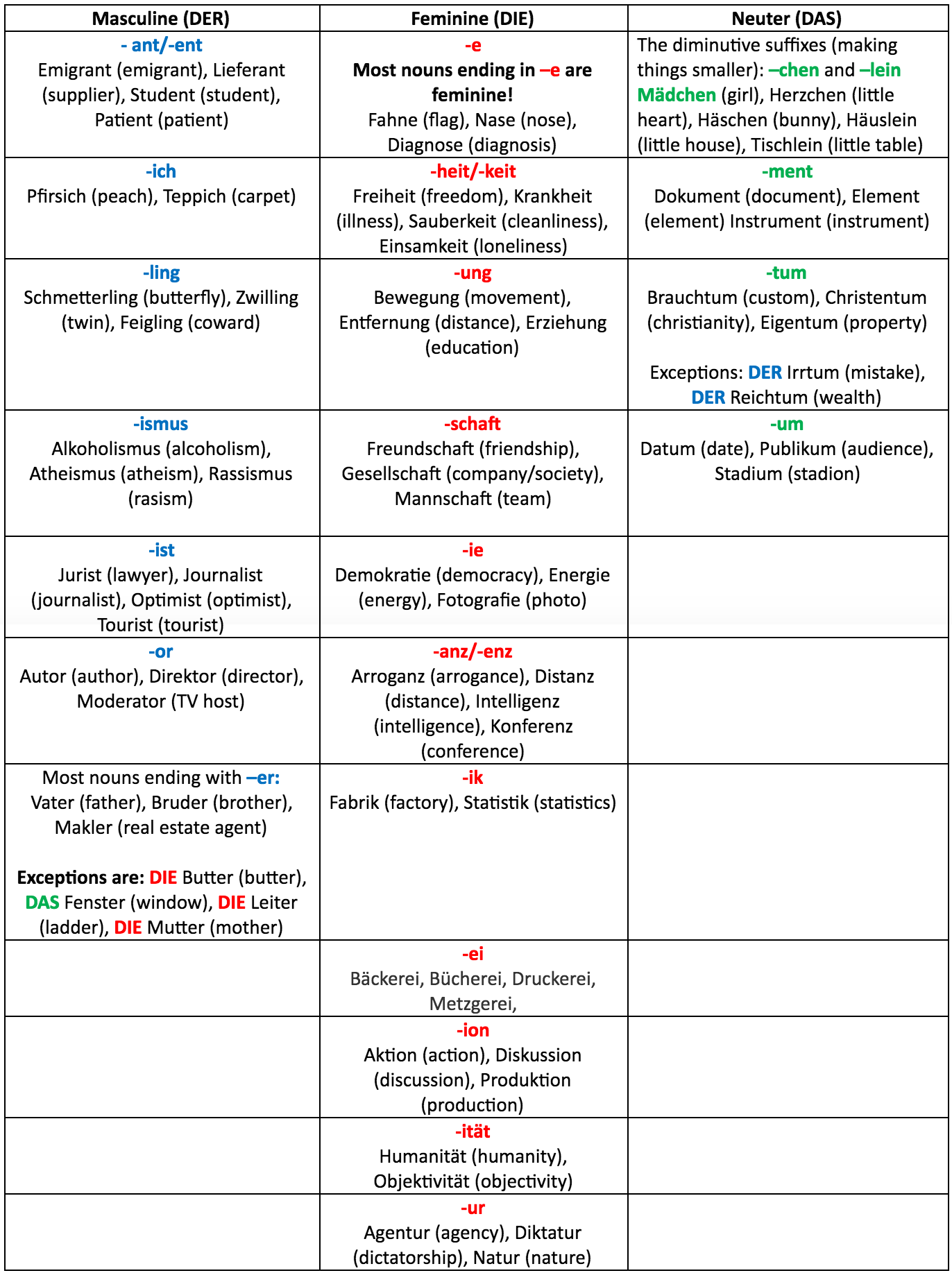
Although this table is not exhaustive or to be taken as 100% correct all of the time, it will work for you 9 out of 10 times for basically half the nouns in the German language. In my book, that’s worth a lot! So the next time you see a new word and it ends in, for example, –ung , -schaft , or –heit/-keit you already know that it’s gender is feminine. Or if something ends in –lein or –chen you know it’s a diminutive and therefore a neuter. Pretty cool, right?
Gender according to certain categories of meaning
One last shortcut to help you with your noun genders and articles is to learn certain categories of meaning that are always the same gender, such as the following.
- times of day, time of the year, months and days of the week (Morgen, Mittag, Abend, Frühling, Sommer, Januar, Februar, Montag, Dienstag…); Exceptions: DIE Nacht (night), DIE Mitternacht (midnight)
- directions: Süden (south), Norden (north), Osten (east), Westen (west), Südwesten (southwest)…
- weather-related words: Hurrikan (hurricane), Monsun (monsoon), Regen (rain), Schnee (snow), Wind (wind); Exceptions: DAS Eis (ice), DIE Kälte (the cold), DIE Hitze (heat), DIE Wolke (cloud) [But then, for Kälte , Hitze and Wolke you already know that they’re feminine, because they end in –e , right? ☺ ]
- alcoholic beverages: Cognac, Rum, Wein (wine); Exception: DAS Bier (beer)
- car brands: Audi, Fiat, Ford…
- motorcycle brands: Honda, Kawasaki, Yamaha…
- names of ships: Titanic, Queen Elizabeth…
- names of cigarettes: Camel, Marlboro
- numbers used as nouns: die Zwei, die Hundert, die Million…
- names of colours: Blau, Rosarot, Schneeweiß…
- nouns that originate from verbs: Essen (eating), Lernen (learning), Reisen (travelling)…
tldr; definite articles in German
So, to sum up, here is your ultimate survival kit for German articles/noun genders in one place:
- Eliminate the genitive case from the declension table (well, at least for now)
- Group the declensions of the definite article for the remaining three cases according to their similarity (check out the color-coded table I used before)
- Try to remember some (or all) of the noun endings that indicate gender, this will help you recognize the gender of almost half the nouns in the German language!
- Have a look at the different categories of words that are always the same gender
And last, but not least:
- Whenever you learn a new word in German, learn its gender at the same time ! This will make life so much easier for you later on. For instance, if you learn the German word for book , which is Buch , always learn and repeat it by including its article, e.g. when studying or taking notes on new vocabulary always say das Buch instead of just Buch.
Ideally, at this point you would also learn its plural form (since it is often irregular), like this:
das Buch – die Bücher
Finally, as someone who has been speaking German all their life and teaching it for 10 years, I would like to offer the following little nugget of wisdom with regard to German articles – don’t worry about them too much. It’s ok to learn their declension, the noun suffixes, etc., I stand by all of the advice I have given in this article. But even if you work really, really hard, study all the cases and endings, always write down the article when learning a new word, you will inevitably make mistakes. Learning a language is all about making mistakes. In fact, I would dare say that it’s much more important to make lots and lots of mistakes, have someone correct you and then learn from these mistakes, than to try to avoid them by not speaking at all. What’s important is to embrace this aspect of language learning and to not get frustrated about making the same mistake a million times.
What’s the best way to learn definite articles in German?
The best you can do to improve your language skills is take the German you know now, at this very moment, and go out into the world (or some online language learning community, for example) and USE IT. It won’t be perfect, it will be chaotic and messy, everything you thought you knew will just disappear and you will find yourself sounding like a complete beginner. And that’s perfectly ok! What’s most important when using a new language is simply being able to establish communication with another person. If you can’t communicate in a language, then you don’t really speak it, do you? And using the wrong article will generally not interfere with your communication or the message you are trying to convey. So, if I were somewhere in Germany, going for a leisurely walk in a historic town, and heard someone scream out
Hilfe! *Die Mädchen hat mir mein Handy gestohlen. (Help! The girl stole my mobile phone.)
I wouldn’t go into walk up to this person and say “Entschuldigung, meinten Sie nicht DAS Mädchen?” – “Excuse me, I believe you meant DAS Mädchen?” (although I might bring this up once the crisis was resolved ☺). No, I would go and try to help this person. It didn’t matter that they used the feminine article instead of the neuter, I could still understand what they were trying to say. That’s what I always emphasize with my students, that they shouldn’t make a fuss when they accidentally used the wrong article because I was still able to understand perfectly well what they were trying to say. And as long as I can do that, they are doing awesome.
Exposure and practice are key
Like with anything in life, learning articles takes a lot of patience and time. There are no quick fixes and it will not come to you overnight, but gradually and with experience. The more you expose yourself to the German language, the easier it will be for you. The best thing you can do is to immerse yourself as much as possible in the German language and culture – to listen to lots of German music, watch German TV shows (there are lots of options for free online) and just try to use it as often as you can. Clozemaster is great for this type of immersion. Whether you play the Grammar Challenge or just the Fast Track, you’ll get plenty of exposure to how German definite articles are used in context. The most successful language learners know that learning to speak a language isn’t about memorizing lots of tables by heart, but about having fun with it. So go out there, have some fun with German, and definite articles will follow suit.
Check out the German definite articles Grammar Challenge on Clozemaster – practice choosing and declining the correct definite article for thousands sentences in German!
9 thoughts on “german definite articles der, die, das: everything you need to know about definite articles in german”.
This has always been my biggest problem with German. Really good advice, thanks.
Thank you so much. Your explanations and examples are very easy to understand and gave me hope that I am on the right track…. Thank you so much. The article chart is what I have been looking for all this while.
First if all. This blog is short but accurate and easy to understand than my time spent in German class for 3 months. After reading this I came to know what is what. Thanks. Ich bin glücklich
Thank you very much , I really appreciate the effort done . The article is obvious and so helpful.
Vielen Dank , ich weiß die Mühe wirklich zu schätzen . Der Artikel ist offensichtlich und so hilfreich
I learned more about gender, articles and nouns from this article than I had learned from several other sources.
My German language skills is zero! Thank you for giving me the courage to start and to carry on. The simply style but deep teaching here just cleared my doubts and fears. I appreciate a million times.
Let’s learn German together!
It is a pleasure to read such a nice article 🙂
Very helpful thank you. I have always said, “Der, Die, Das -der verruck worten.” I only got to live in Germany for 30 months. I traveled a lot. I often hear the native speakers using different articles; particularly from North to South. Much like the US the accent was very different as well.
Leave a Comment Cancel Reply
Your email address will not be published. Required fields are marked *
Save my name, email, and website in this browser for the next time I comment.
Expand your vocabulary in another language
Get Clozemaster and take your language skills to the next level.
“Clozemaster is THE best app to learn a language after Duolingo.”

- Skip to primary navigation
- Skip to main content
- Skip to primary sidebar
- Skip to footer
Legal Templates
Home Business Assignment Agreement
Assignment Agreement Template
Use our assignment agreement to transfer contractual obligations.

Updated February 1, 2024 Reviewed by Brooke Davis
An assignment agreement is a legal document that transfers rights, responsibilities, and benefits from one party (the “assignor”) to another (the “assignee”). You can use it to reassign debt, real estate, intellectual property, leases, insurance policies, and government contracts.
What Is an Assignment Agreement?
What to include in an assignment agreement, how to assign a contract, how to write an assignment agreement, assignment agreement sample.

Partnership Interest
An assignment agreement effectively transfers the rights and obligations of a person or entity under an initial contract to another. The original party is the assignor, and the assignee takes on the contract’s duties and benefits.
It’s often a requirement to let the other party in the original deal know the contract is being transferred. It’s essential to create this form thoughtfully, as a poorly written assignment agreement may leave the assignor obligated to certain aspects of the deal.
The most common use of an assignment agreement occurs when the assignor no longer can or wants to continue with a contract. Instead of leaving the initial party or breaking the agreement, the assignor can transfer the contract to another individual or entity.
For example, imagine a small residential trash collection service plans to close its operations. Before it closes, the business brokers a deal to send its accounts to a curbside pickup company providing similar services. After notifying account holders, the latter company continues the service while receiving payment.
Create a thorough assignment agreement by including the following information:
- Effective Date: The document must indicate when the transfer of rights and obligations occurs.
- Parties: Include the full name and address of the assignor, assignee, and obligor (if required).
- Assignment: Provide details that identify the original contract being assigned.
- Third-Party Approval: If the initial contract requires the approval of the obligor, note the date the approval was received.
- Signatures: Both parties must sign and date the printed assignment contract template once completed. If a notary is required, wait until you are in the presence of the official and present identification before signing. Failure to do so may result in having to redo the assignment contract.
Review the Contract Terms
Carefully review the terms of the existing contract. Some contracts may have specific provisions regarding assignment. Check for any restrictions or requirements related to assigning the contract.
Check for Anti-Assignment Clauses
Some contracts include anti-assignment clauses that prohibit or restrict the ability to assign the contract without the consent of the other party. If there’s such a clause, you may need the consent of the original parties to proceed.
Determine Assignability
Ensure that the contract is assignable. Some contracts, especially those involving personal services or unique skills, may not be assignable without the other party’s agreement.
Get Consent from the Other Party (if Required)
If the contract includes an anti-assignment clause or requires consent for assignment, seek written consent from the other party. This can often be done through a formal amendment to the contract.
Prepare an Assignment Agreement
Draft an assignment agreement that clearly outlines the transfer of rights and obligations from the assignor (the party assigning the contract) to the assignee (the party receiving the assignment). Include details such as the names of the parties, the effective date of the assignment, and the specific rights and obligations being transferred.
Include Original Contract Information
Attach a copy of the original contract or reference its key terms in the assignment agreement. This helps in clearly identifying the contract being assigned.
Execution of the Assignment Agreement
Both the assignor and assignee should sign the assignment agreement. Signatures should be notarized if required by the contract or local laws.
Notice to the Other Party
Provide notice of the assignment to the non-assigning party. This can be done formally through a letter or as specified in the contract.
File the Assignment
File the assignment agreement with the appropriate parties or entities as required. This may include filing with the original contracting party or relevant government authorities.
Communicate with Third Parties
Inform any relevant third parties, such as suppliers, customers, or service providers, about the assignment to ensure a smooth transition.
Keep Copies for Records
Keep copies of the assignment agreement, original contract, and any related communications for your records.
Here’s a list of steps on how to write an assignment agreement:
Step 1 – List the Assignor’s and Assignee’s Details
List all of the pertinent information regarding the parties involved in the transfer. This information includes their full names, addresses, phone numbers, and other relevant contact information.
This step clarifies who’s transferring the initial contract and who will take on its responsibilities.
Step 2 – Provide Original Contract Information
Describing and identifying the contract that is effectively being reassigned is essential. This step avoids any confusion after the transfer has been completed.
Step 3 – State the Consideration
Provide accurate information regarding the amount the assignee pays to assume the contract. This figure should include taxes and any relevant peripheral expenses. If the assignee will pay the consideration over a period, indicate the method and installments.
Step 4 – Provide Any Terms and Conditions
The terms and conditions of any agreement are crucial to a smooth transaction. You must cover issues such as dispute resolution, governing law, obligor approval, and any relevant clauses.
Step 5 – Obtain Signatures
Both parties must sign the agreement to ensure it is legally binding and that they have read and understood the contract. If a notary is required, wait to sign off in their presence.

Related Documents
- Purchase Agreement : Outlines the terms and conditions of an item sale.
- Business Contract : An agreement in which each party agrees to an exchange, typically involving money, goods, or services.
- Lease/Rental Agreement : A lease agreement is a written document that officially recognizes a legally binding relationship between two parties -- a landlord and a tenant.
- Legal Resources
- Partner With Us
- Terms of Use
- Privacy Policy
- Do Not Sell My Personal Information

The document above is a sample. Please note that the language you see here may change depending on your answers to the document questionnaire.
Thank you for downloading!
How would you rate your free template?
Click on a star to rate
Best Practices for Writing a Global Assignment Letter Of Understanding
By Laura Wilkins, CRP, GMS
Those who have relocated globally can attest to the life-changing nature of an overseas assignment—often requiring that the employee sell a home in addition to moving their family to a new country and changing many of their typical routines. Your employee letter of understanding must cover a number of important topics sensitively but clearly—without increasing already high stress levels.
A letter of understanding outlines the details and benefits of an international assignment. This legally binding document, which all parties must sign, serves as an addendum to the employee’s regular employment contract and lays out any differing terms that apply. In addition to the assignment start and end date, job title, and location, the letter of assignment must specify all contractual agreements, a code of conduct, compensation, assignment-specific benefits such as moving expenses, and any repatriation allowance or tax equalization provided.
The letter of understanding should specify all pertinent details without leaving any room for interpretation. Lack of clarity can lead to misunderstandings and costly mistakes which drain resources and distract the employee, impacting the success of the assignment.
The key to drafting effective letters of understanding begins with knowing your employees and focusing on their needs and their families’ needs. You may find sample templates online to help you draft a letter of understanding, but unfortunately, many of them begin like this:
Dear Mr. Jones,
This letter is to inform you that you will be transferred effective [date] to our location in…
Considering the upheaval a relocation will cause in your employee’s life, this approach may come across as overly abrupt. Here are some best practices to help you write an effective letter of understanding.
Discuss the Global Relocation or Assignment First

Having a detailed discussion provides an opportunity to create enthusiasm about a new role by:
- Providing a platform to discuss your global mobility policy and company-provided financial assistance
- Clarifying the specific skill-building and learning opportunities available in the new role
- Showing that the company values the employee and wants to make an investment in his or her future
- Demonstrating that the employee is important to the growth of the business
Holding a preliminary discussion shows respect for the employee and allows you to craft a letter tailored to that individual. In turn, this will likely increase loyalty and productivity and reduce the chance of a declined relocation offer.
Outline the New Role
Your employee’s job title and responsibilities may remain the same in the new location. If so, make sure the letter of understanding includes the name of the person to whom the employee will report and the duration of the transfer or assignment. For employees taking on new responsibilities, you’ll also want to include the following:
- The employee’s new job title or position
- A description of any increased benefits, salary or bonuses
Similar in some ways to an employment offer letter, this portion of the letter of understanding focuses on the specifics of the new role. It documents the job title, salary, and related benefits to eliminate misunderstandings. The appropriate manager should sign and date the letter, and it should include the:
- Employee’s full name and current home address.
- Department names — both the current department and the new destination department.
- Effective date the employee should report to the new location.
- Anticipated end date in the case of an assignment.
- Name of the employee’s new manager.
- Expiration date for the individual’s relocation and assignment benefits.
After you provide this information, you can delve into the specifics of your company’s global mobility policy and explain the benefits the employee will receive. If you’re looking for additional resources on transfer notices, check out our page on 12 Employee Transfer Letter Tips.
- Share on Facebook
- Share on Twitter
- Share on LinkedIn
- Share with Email
Insights + Resources
How much is the average relocation package in 2024, gross-up: a guide to employer-paid relocation tax assistance, what is an executive relocation package, how to build an effective hr communication strategy.
- Sample Letters
FREE 9+ Sample Assignment Letter Templates in PDF | MS Word

An assignment letter is a document that is used mostly in situations such as business bankruptcy and insolvency. It is a legal document which can be presented in courts when handling different cases. Examples of scenarios whereby this paper comes in are when a business owner is assigning a portion of his or her assets to a trustee for selling purposes and also when assigning specific rights to another person such as collecting payment on your behalf.
Assignment Letter
Sample personal business letter - 9+ documents in pdf, word, sample thank you letter to boss - 22+ free documents download ..., sample trademark assignment form - 7+ examples in pdf.
Our assignment templates get designed in the best way possible to usher you properly when creating one. An assignment letter template may also be said to be a Professional Letter of assignment or an assignment letter sample.
Salary Assignment Letter

Size: 130 KB
The top of the page should have the name of the person or the entity issuing the letter together with their personal information such as the telephone number, email address, and the postal address. Below that it should indicate that it is a letter of assignment to give the form an identity. Next should be the full names of the people or entity in the agreement alongside their personal information.
After that, mention the duration of the assignment and the location of where the deal takes place. The body of the document should be concluded by listing all the details of the money that they parties will be handling. Finally, the parties involved should sign the paper to seal the agreement.
Appraisal Assignment Letter
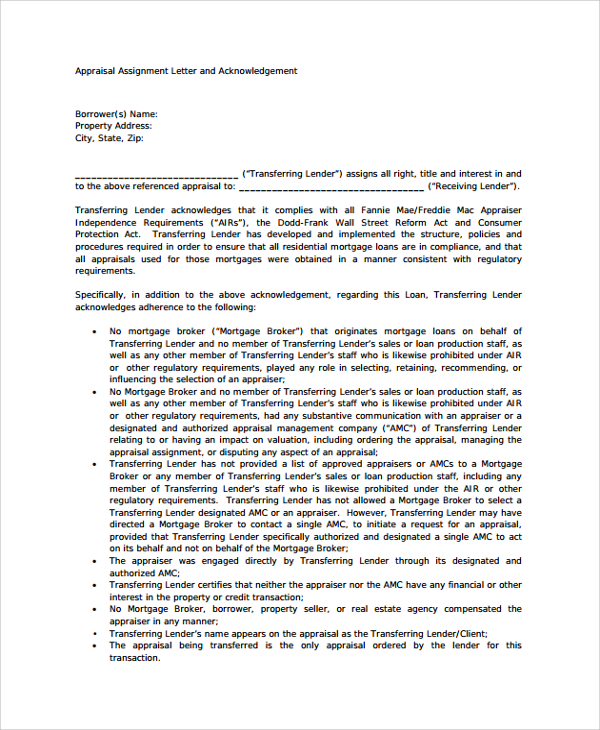
Size: 38 KB
The top of the form should read that the document is an appraisal assignment letter for easier identification. The name plus the postal address of the person or company issuing the appraisals should be listed next. After that, a declaration statement mentioning the names of the parties involved in the agreement should be put down saying who has assigned rights to the other.
The agreement should always comply with the standards set by law. Other acknowledgments that each party is supposed to heed to should also get listed in this document. The model should conclude by stating the period when the agreement will be active.
Voided Assignment Letter
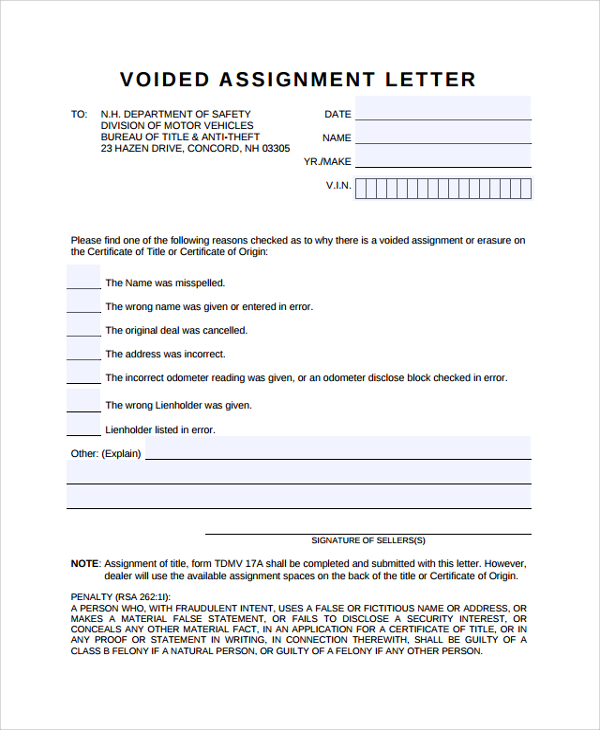
Size: 37 KB
The top of the model should read that it is a voided assignment letter for quick identification of the form. After that, on the left, the name of the person of corporate who is going to receive the document is listed together with other personal information such as a postal address and an email address.
The right should have the date of when the paper gets published. Finally, the reasons as to why there is a voided assignment letter must be on it and signatures of the parties involved should also be given to show that they agree with the stated reasons.
Incentive Assignment Letter
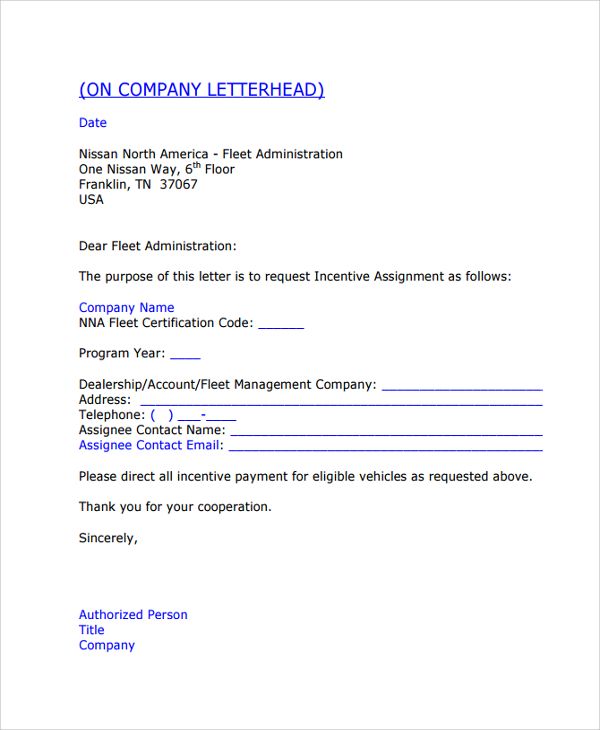
Size: 42 KB
The name of the company issuing the letter should be the first thing on the document and the date below that. Next should be the name and personal details of the person or entity meant to receive it. The incentive assignment should be listed giving all crucial information about it and contacts which the receiver can contact for further negotiations. Finally, it concludes with a short formal message to the receiver.
Professional Assignment Letter
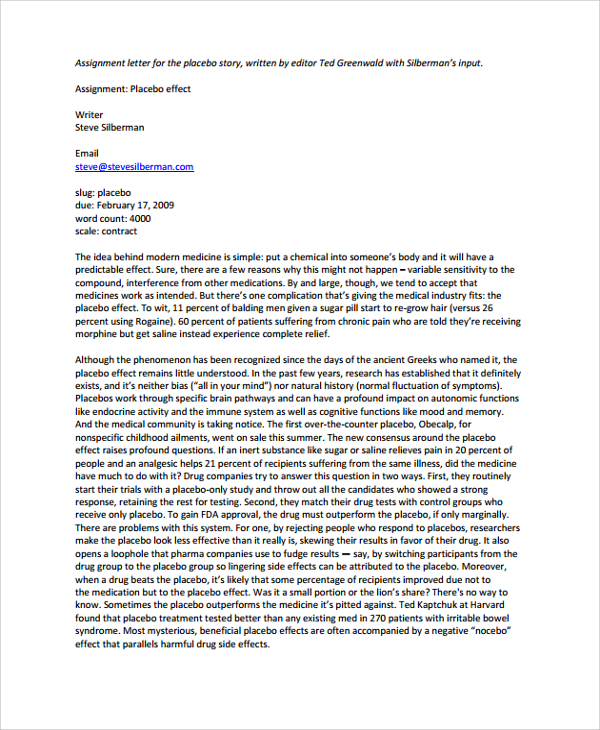
Size: 355 KB
Buddy Assignment Letter
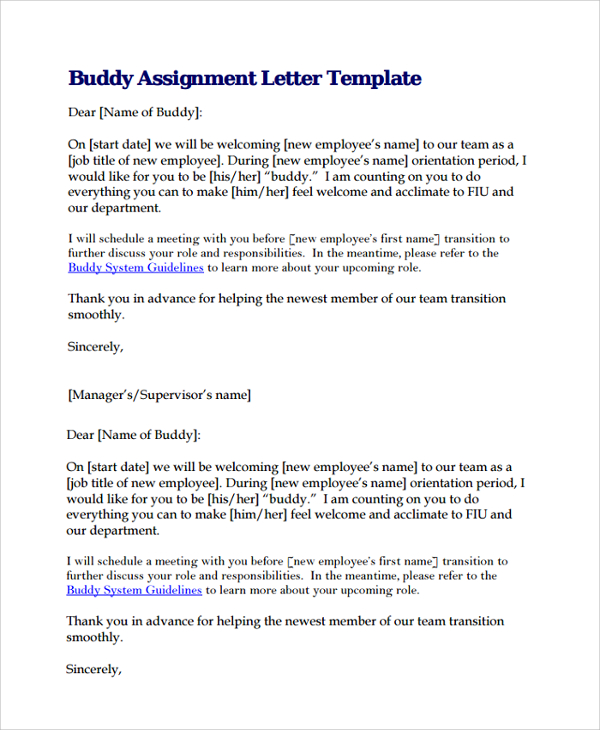
Size: 155 KB
Friendly Assignment Letter
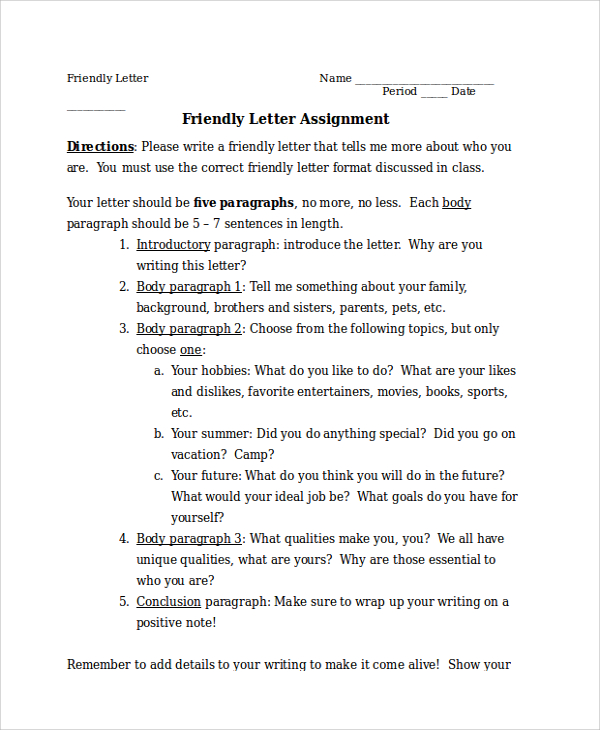
Size: 31 KB
Sample Assignment Letter
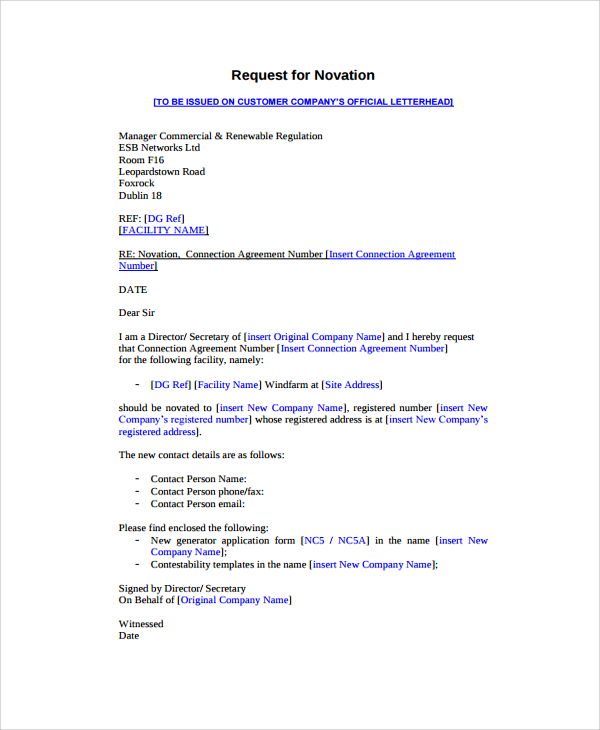
Size: 137 KB
Assignment Letter from Trainee
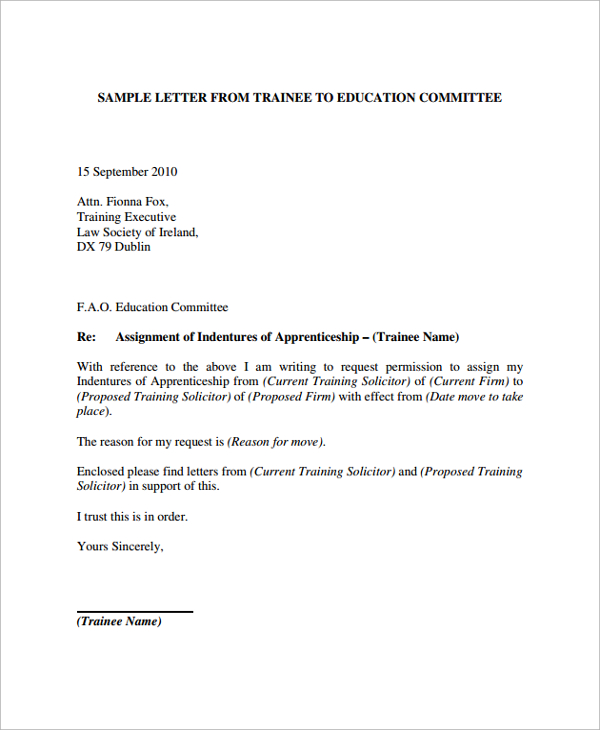
Volunteer Assignment Letter
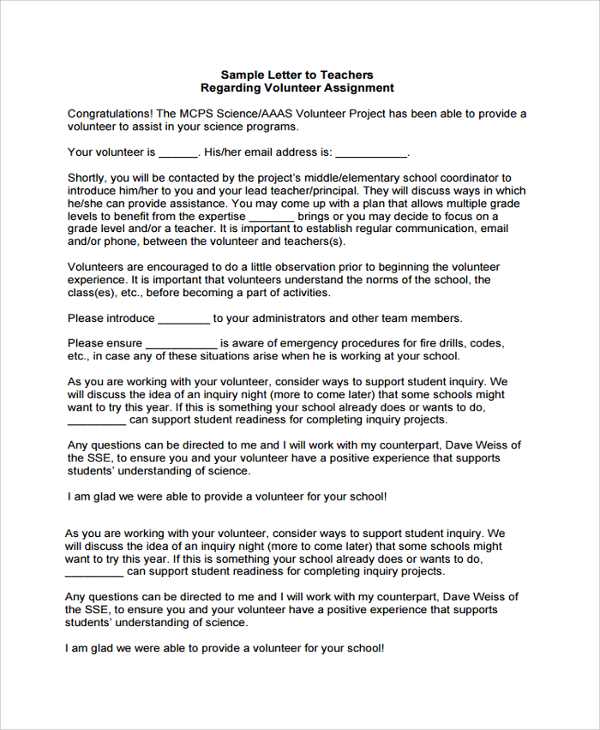
Size: 52 KB
What are the Advantages of Having our Assignment Letter Templates?
One may lack sufficient knowledge on what to include when forming this document; therefore, the main benefit of having our template is that it gives you the proper guidance on which information to include in your paper and an order of how to put it down.
Another advantage is that our templates are files which you can save on you PC; thus, you can make references from the file again in future when forming assignment letters. Finally, our templates are always designed to help you create one as per the standard legal requirements. You may also see Sample Personal Letters
How Have We Made our Assignment Letter Templates the Best for you?
Our models get worked on by the experts whom we have interviewed thoroughly and proven that they are talented. We also ensure that they have sufficient experience in the field for our templates to be as effective for you as possible. Another way we have made our templates the best for you is by making them editable such that you can do any modifications you prefer on them. Finally, they are printable for you to be able to make as many copies as you want. You may also see Friendly Letters
Which are the Most Crucial Aspects that I Should Entail in my Assignment Letter?
Always list the name of parties in the agreement and also sufficient personal information about them. Never forget to indicate the date you publish the model and the period of how long the contract will be valid. Ensure that both parties agree on what gets stated on the Professional Letters then seal the deal with signatures of each. Finally, since it is a legal document, always ensure that your agreement complies with the provisions of the law to avoid awful penalties.
We ensure that we meet the requirements of all our customers according to their needs. Those that would want a fully customed model can always communicate to us so that we can direct you to our experts to help them understand what kind of make you want. We have customer care agents that are always available to tend to all the inquiries you may have and the consultations you may need. Consider acquiring our accessible and affordable assignment letter template today, to guide you while creating the document you need.
If you have any DMCA issues on this post, please contact us !
Related Posts
Sample visa invitation letter templates, how to write an application letter for employment [ with samples ], sample community service letter templates, sample commitment letter templates, sample application letter templates, letterhead samples, sample visa sponsorship letter templates, application letter templates, sample job application cover letter templates, formal excuse letter templates, leave letter templates, sick leave letter templates, free 10+ sample inform letter templates in pdf, free 13+ sample closing business letter templates in pdf | ms word | google docs | pages, 10 free notice to quit letter samples & templates, sample assignment of contract - 6+ free documents download in ..., sample assignment of mortgage template - 9+ free documents ..., sample assignment agreement template - 9+ free documents ..., sample appointment letter - 28+ download free documents in pdf ....

Dictionary of International Trade
Letter of assignment.
A document with which the assignor assigns rights to third party. See assignment .
Related entries
- Warehouse receipt
- Trust receipt
- Statement of Work (SOW)
Search Terms
- Banking (206)
- Contracts & Law (190)
- Customs (130)
- Documentation (111)
- Economics (173)
- Insurance (54)
- Logistics (401)
- Marketing (139)

Practical Guide to Incoterms

- Contracts & Law
- Documentation
- International Contracts
- Chinese Contracts
- Country Guides
- Business Letters
- Trade Documents
Advertising - LEO ohne Werbung? LEO Pur
It looks like you’re using an ad blocker.
Would you like to support LEO?
Disable your ad blocker for LEO or make a donation.
Donate via bank transfer
Donate via paypal.

Suchrichtung
Preferred vocabulary, in multi-word searches .

Popular search terms
Bitte aktualisieren Sie Ihren Browser. Ihr Browser ist veraltet, daher kann es zu Einschränkungen in der Funktionalität kommen.
Die reine Wörterbuchsuche wird im InternetExplorer in Version 8 und 9 noch unterstützt (ohne Gewähr auf funktionierende Zusatzdienste wie Aussprache, Flexionstabellen etc.). Siehe dazu auch die offizielle Ankündigung durch Microsoft zum Support-Ende der verschiedenen InternetExplorer-Versionen.
| die Aufgaben | |||||||
| ] ] | die Übertragungen | ||||||
| ] | die Vergaben | ||||||
| die Aufträge | |||||||
| Arbeitseinsatz die Arbeitseinsätze | |||||||
| die Anweisungen | |||||||
| Aufgabengebiet die Aufgabengebiete | |||||||
| die Einsätze - | |||||||
| Festsetzung die Festsetzungen | |||||||
| Überweisung die Überweisungen | |||||||
| die Verwendungen | |||||||
| Zuordnung die Zuordnungen | |||||||
| Aufgabenzuteilung die Aufgabenzuteilungen | |||||||
| ] | |||||||
| , , , , , , , , , , , , , , | |
Other actions

- Special characters
- Type Chinese Pinyin syllables to get a list of corresponding Chinese characters.
- Transliteration aktiv Tastaturlayout Phonetisch
What you’re looking for is not yet in our dictionary? Ask the LEO community.
- iPhone / iPad
- Tools for browsers
- About us / LEO’s history
- Advertising with LEO
- My account
- Change password
- Unread forum posts
- unread private messages
- Learn today’s words
- Continue the language course
- EXPLORE Random Article
How to Draft an Assignment of Contract
Last Updated: January 23, 2022
This article was co-authored by Clinton M. Sandvick, JD, PhD . Clinton M. Sandvick worked as a civil litigator in California for over 7 years. He received his JD from the University of Wisconsin-Madison in 1998 and his PhD in American History from the University of Oregon in 2013. This article has been viewed 5,350 times.
A contract is an agreement between at least two parties—A and B. However, one party might want to transfer the contract to someone else. For example, B might want to assign its rights and obligations to C. Sometimes, a contract prohibits assignment, in which case B can’t assign the contract to anyone. In other contracts, the other party to the original contract (here Party A) must also agree to the assignment from B to C. If the contract allows assignment, then an assignment can take place once a proper assignment agreement has been created.
Starting the Assignment Agreement

- If you are printing the agreement on letterhead, make sure to leave enough room at the top.

- Sample language could read, “This Assignment (‘Assignment’), dated as of [insert date] (‘Effective Date’), is made between [insert your name] (‘Assignor’) and [insert the name of the assignee] (‘Assignee’).” [1] X Research source

- Sample recitals could read, “Whereas, Assignor entered into the following Contract with [the name of the party you contracted with, called the ‘obligor’] on [insert date of the contract] (‘Contract’); and whereas Assignor wishes to assign all of its rights and obligations under the Contract to Assignee. Now, therefore, Assignor and Assignee agree as follows.”
Granting the Assignment

- A sample grant could read: “Assignor and Assignee hereby agree that the Assignor shall assign all its title, right, and interest, and delegate all its obligations, responsibilities, and duties, in and to the Contract to Assignee.”

- “Assignee hereby accepts the assignment of all of Assignor’s obligations, responsibilities, and duties under the Contract and all of Assignor’s right, title, and interest in and to the Contract.”

- A sample modification provision could read: “This Agreement may only be modified if the modification is made in writing and executed by both Assignor and Assignee. No verbal agreement is allowed.”

- The assignor could agree to indemnify the obligor: “Assignor agrees to defend and indemnify [insert name of the obligor] from any and all claims, judgments, actions, proceedings, liabilities, and costs, including reasonable attorneys’ fees and other costs of defense and damages, resulting from Assignor’s performance prior to the assignment of the Contract and resulting from Assignee’s performance after the assignment of the Contract. However, after the assignment of the Contract, [insert name of the obligor] shall first look to Assignee to satisfy all claims, actions, judgments, proceedings, liabilities, and costs, including reasonable attorneys’ fees and other costs of defense and damages resulting from Assignee’s performance.”
- The assignee should also agree to indemnify the obligor: “Assignee agrees to indemnify the [insert name of obligor] from any and all claims, judgments, actions, proceedings, liabilities, and costs, including reasonable attorneys’ fees and other costs of defense and damages, resulting from Assignee’s performance after the assignment of the Contract.”
Finalizing the Agreement

- You could write, “This Assignment shall be construed and interpreted, and the rights of the parties determined by, the laws of the State of Maine (without regard to the conflicts of law principles thereof or any other jurisdiction).” [2] X Research source

- A sample clause could read, “If any part of this Agreement is declared invalid or unenforceable, the remainder of the Agreement shall continue to be valid and enforceable.” [3] X Research source

- Just above the signature line, insert: “In witness whereof, the parties have caused this Assignment to be duly executed as of the date first written above.” [4] X Research source

- If you don’t have an attorney, then you should contact your local or state bar association and ask for a referral.
- When scheduling the consultation, ask how much the attorney charges.
Expert Q&A
You might also like.

- ↑ http://contracts.onecle.com/annies/baking-assignment-2014-03-20.shtml
- ↑ http://www.contractstandards.com/clauses/severability
About this article

Reader Success Stories
Luciana Alencar
Dec 20, 2017
Did this article help you?

- About wikiHow
- Terms of Use
- Privacy Policy
- Do Not Sell or Share My Info
- Not Selling Info

IMAGES
VIDEO
COMMENTS
Besichert ist dieses Darlehen durch Grundschulden zu Lasten des Erbbaurechts auf dem Erbbaugrundstück in Frankfurt-Niederrad in Höhe von TEUR 4.000, durch Abtretung von Miete für das Bürogebäude in vorerst stiller Form sowie durch eine Patronatserklärung der ADLER für die konsolidierte Tochtergesellschaft, die das Grundstück hält.
assignment as security. assignment letter. assignment of a claim for security. assignment of claim. assignment range. assignor. assign to. Look up the English to German translation of assignment letter in the PONS online dictionary. Includes free vocabulary trainer, verb tables and pronunciation function.
A letter of assignment is a critical document in various business, academic, and professional settings. It formally assigns responsibilities, tasks, or roles from one party to another. Understanding how to craft an effective letter of assignment can ensure clear communication and smooth transitions in responsibilities.
Many translated example sentences containing "letter of assignment" - German-English dictionary and search engine for German ... das SF-97/ Release Document ebenfalls auszuhändigen. ... (im Zusagebrief enthalten; der Abschnitt zur unterkunft ist nur von Empfängern eines ein- oder zweijährigen Stipendiums auszufüllen) rotary.org.
Assignment schreiben als Grundlage. Der Begriff des Assignments im Bildungsbereich bedeutet, dass Studenten mit einer Aufgabe betraut werden, die außerhalb der Vorlesungen oder S
Danke im Voraus. Learn the translation for 'assignment\x20letter\x20of' in LEO's English ⇔ German dictionary. With noun/verb tables for the different cases and tenses links to audio pronunciation and relevant forum discussions free vocabulary trainer .
What this handout is about. The first step in any successful college writing venture is reading the assignment. While this sounds like a simple task, it can be a tough one. This handout will help you unravel your assignment and begin to craft an effective response. Much of the following advice will involve translating typical assignment terms ...
Das Assignment ist eine schriftliche Prüfungsform des Studien- bereichs Wirtschaft, bei der Studierende individuell eine oder mehrere Fragestellungen innerhalb eines festgelegten Zeitraums schriftlich bearbeiten müssen. Bei dieser Prüfungsform wird währ- end des Semesters und unter Zeitdruck geprüft. Diese beiden Be-
Übersetzung Englisch-Deutsch für assignment letter im PONS Online-Wörterbuch nachschlagen! Gratis Vokabeltrainer, Verbtabellen, Aussprachefunktion. ... Ursache dafür ist, dass Linux eigene Regeln für die Benennung von Laufwerken verwendet ( siehe Kapitel 2.1.1 Naming Convention unter http : / / www.ibiblio.org / pub / Linux / docs / HOWTO ...
Lernen Sie die Übersetzung für 'letter\x20of\x20assignment' in LEOs Englisch ⇔ Deutsch Wörterbuch. Mit Flexionstabellen der verschiedenen Fälle und Zeiten Aussprache und relevante Diskussionen Kostenloser Vokabeltrainer
The answer is as detailed as possible. The assignment letter should be a legally binding document, confirming the agreement between the company and the assignee with respect to the terms and conditions of the assignment. In reality, the most common approach is that the assignee remains employed with the home company and the home employment ...
Es geht um eine vertragliche Zusatzvereinbarung. Zuvor gab es im Vertrag einen Paragraf "Novation to EPC Contractor" (sinngemäß die Beauftragung eines Generalunternehmers), welche nun durch eine Anlage, die als "Assignment Letter" bezeichnet wird, ersetzt werden soll. ...
That's where an assignment letter comes in handy. After you and a freelancer have agreed on a story, recap the discussion in writing and send your letter (or e-mail message) to the writer. It will help you get the piece you want. Once you've read through the guidelines below, have a look at our sample letter (a downloadable PDF document).
Free Assignment Letter Template Active Voice Communications 2019-10-01T18:31:45+00:00 Assigning content to writers takes time if you do it right. It's important to give your writers as much information as you can so they can create the content you need.
Das Assignment hat circa den Umfang einer Hausarbeit, daher ist es insbesondere für kleine bis mittlere Veranstaltungen geeignet. Zeitaufwand Der Zeitaufwand verteilt sich über das Semester und ist bezogen auf die Korrektur ähnlich hoch wie bei Hausarbeiten. Aufwand entsteht durch die mehrfache Rückspiegelung der Ergebnisse. Raumausstattung
Our experienced Consultants are on hand to critique your company's assignment letters and, if required, create assignment letter templates in line with your policy, as well as offer expert advice and guidance on content so that your assignment letters accurately manage the expectations of the employee and the company. Next. Assignee and HR ...
Therefore, in German, the words from the above example also have genders, even though they do not originate from the characteristics of the object, but are assigned somewhat randomly. In German "chair" is masculine (DER Stuhl), "book" is neuter (DAS Buch) and "apartment" is feminine (DIE Wohnung). The article DIE is also used to for ...
Begin with a condensed section with the most important information. Secondly, include goals and preparation steps. Clearly highlight important items with bullet points or bold letters. End with the least important information: formatting, page numbers, etc. Make sure you have clearly separated the "getting started" section on your ...
Execution of the Assignment Agreement. Both the assignor and assignee should sign the assignment agreement. Signatures should be notarized if required by the contract or local laws. Notice to the Other Party. Provide notice of the assignment to the non-assigning party. This can be done formally through a letter or as specified in the contract.
The letter of understanding should specify all pertinent details without leaving any room for interpretation. Lack of clarity can lead to misunderstandings and costly mistakes which drain resources and distract the employee, impacting the success of the assignment. The key to drafting effective letters of understanding begins with knowing your ...
gl.ch. Details. File Format. PDF. Size: 130 KB. Download. The top of the page should have the name of the person or the entity issuing the letter together with their personal information such as the telephone number, email address, and the postal address. Below that it should indicate that it is a letter of assignment to give the form an identity.
Letter of assignment. A document with which the assignor assigns rights to third party. See assignment.
assignment die Aufgabe pl.: die Aufgaben assignment [FINAN.] [LAW] die Übertragung pl.: die Übertragungen assignment [TECH.] die Vergabe pl.: die Vergaben assignment der Auftrag pl.: die Aufträge assignment der Arbeitseinsatz pl.: die Arbeitseinsätze assignment die Anweisung pl.: die Anweisungen assignment das Aufgabengebiet pl.: die ...
Format your document. Open a blank word processing document. Set the font to a readable size and style. For example, Times New Roman 12 point works for many people, though you can choose something different if you want. 2. Insert a title. At the top of the page, insert "Assignment Agreement.".